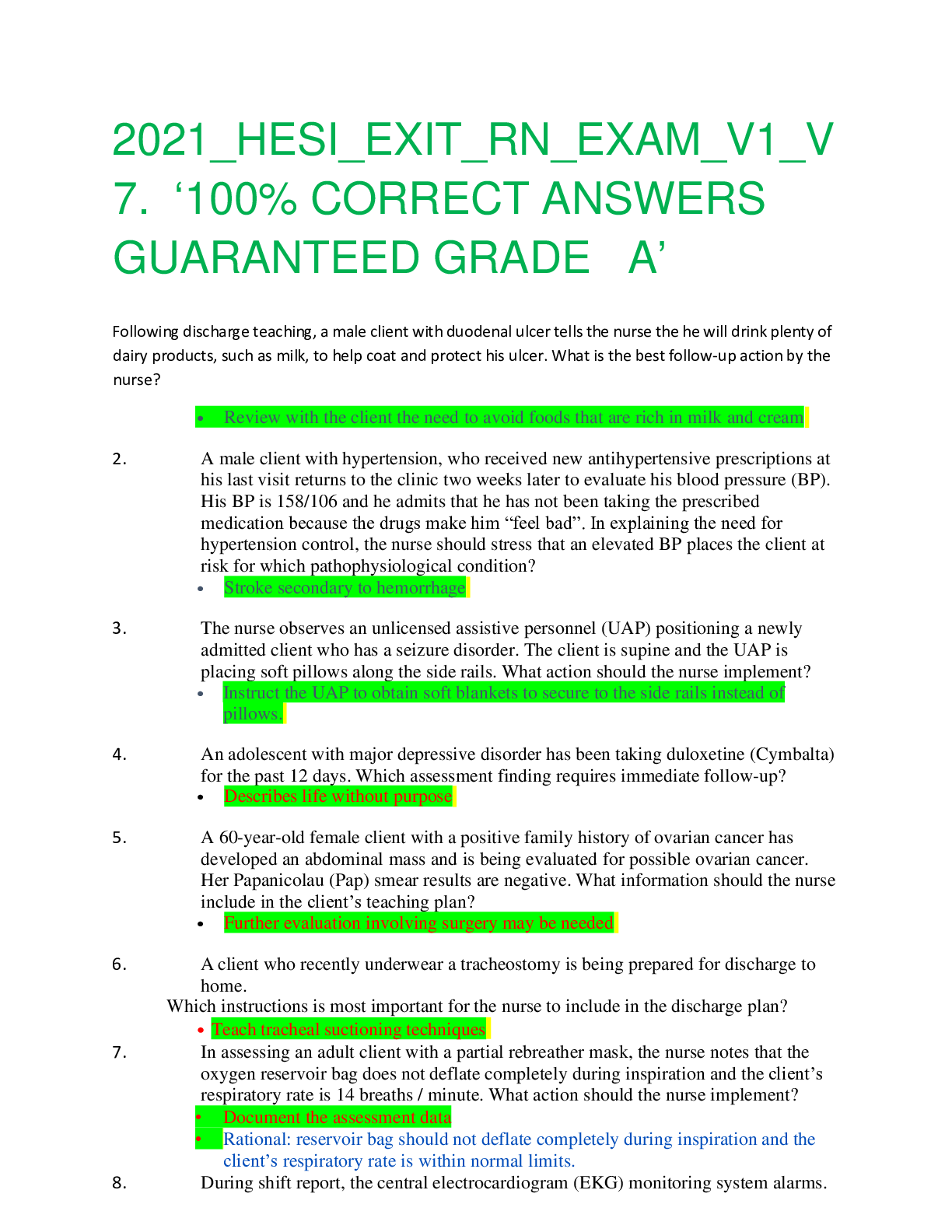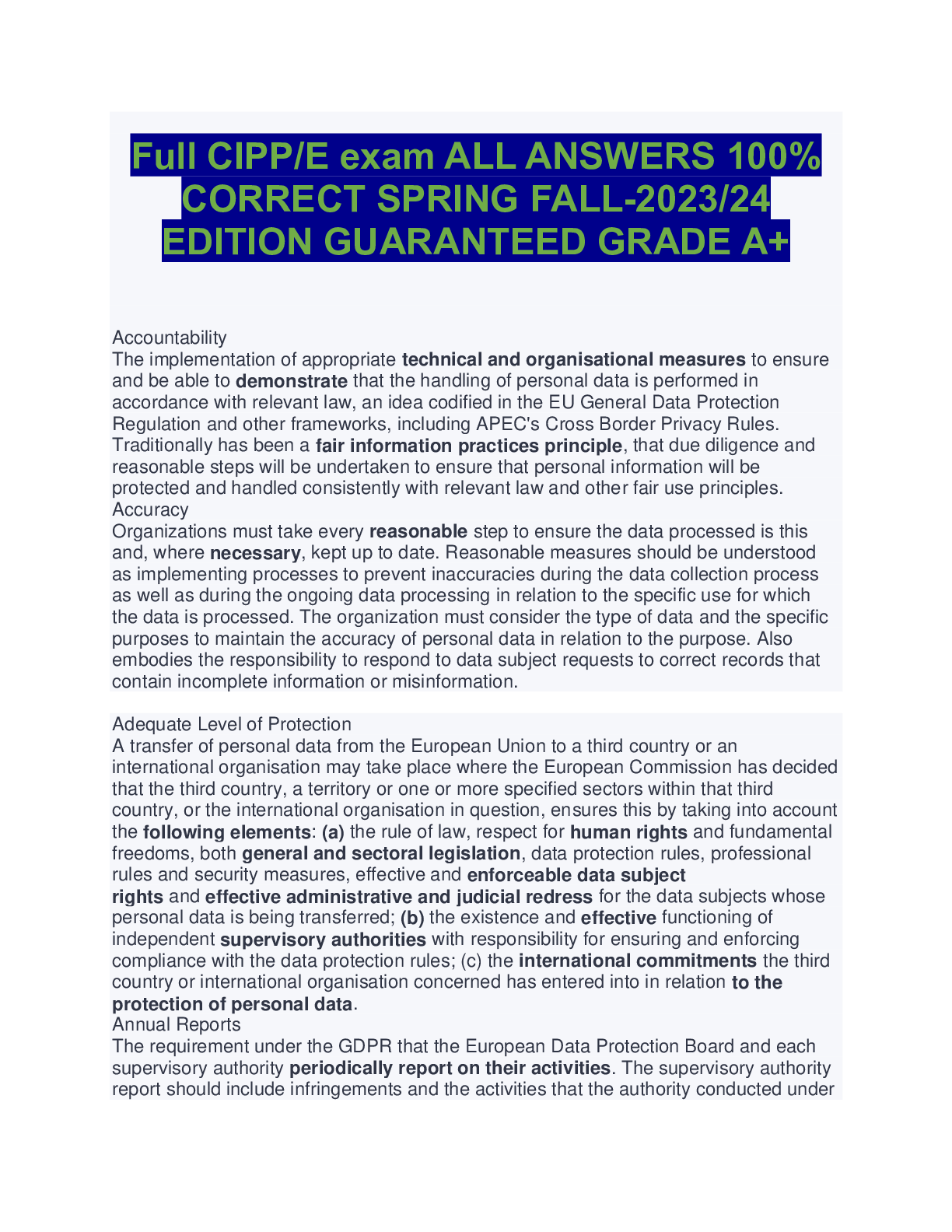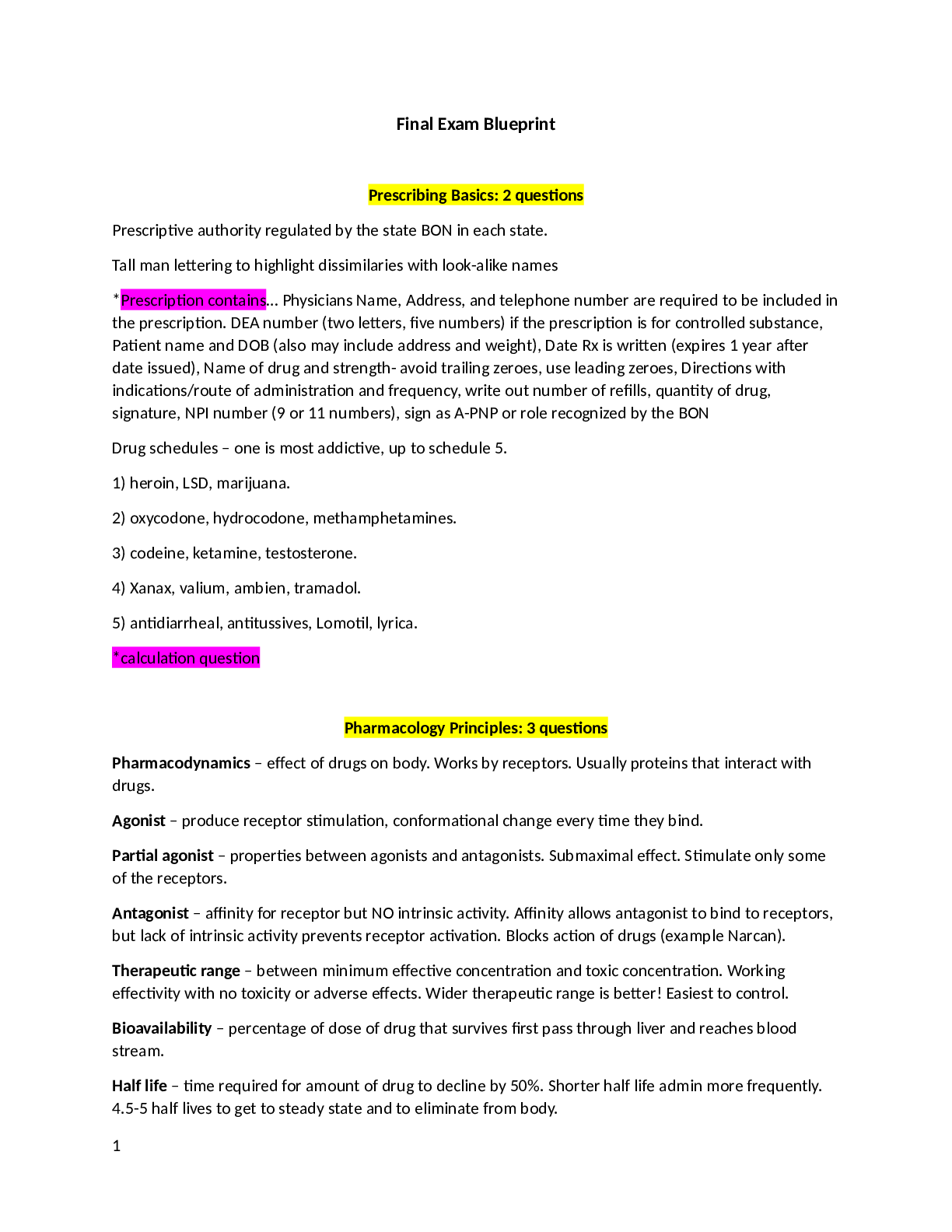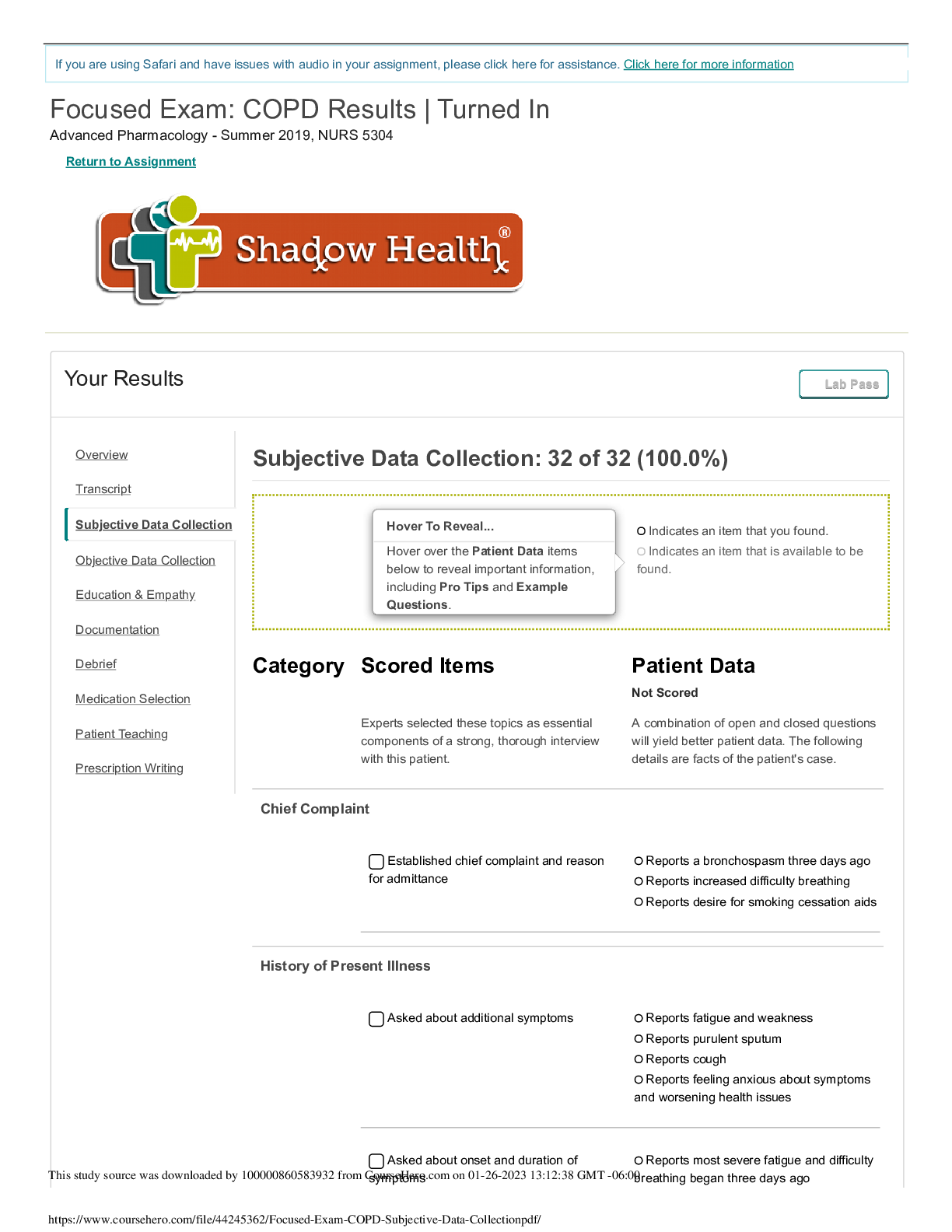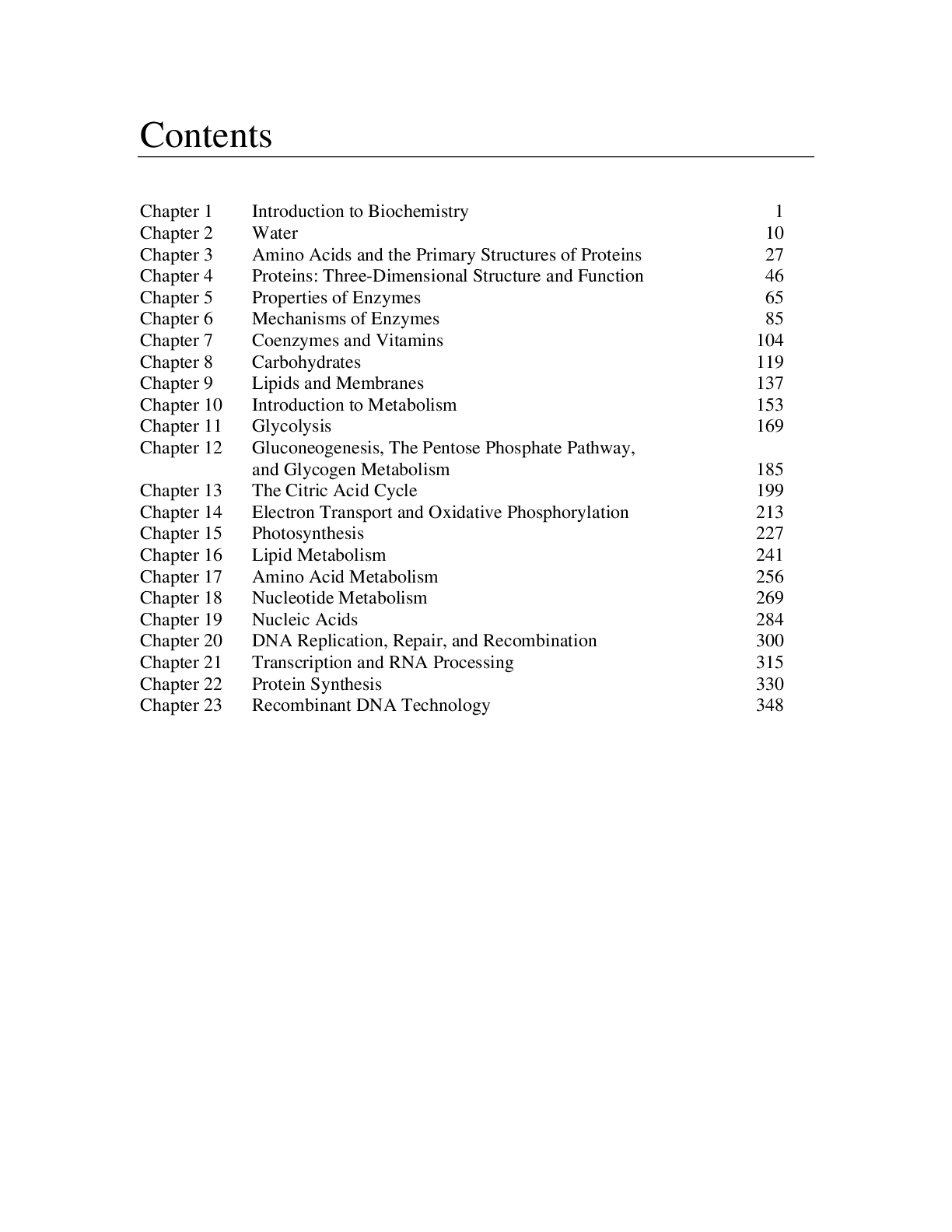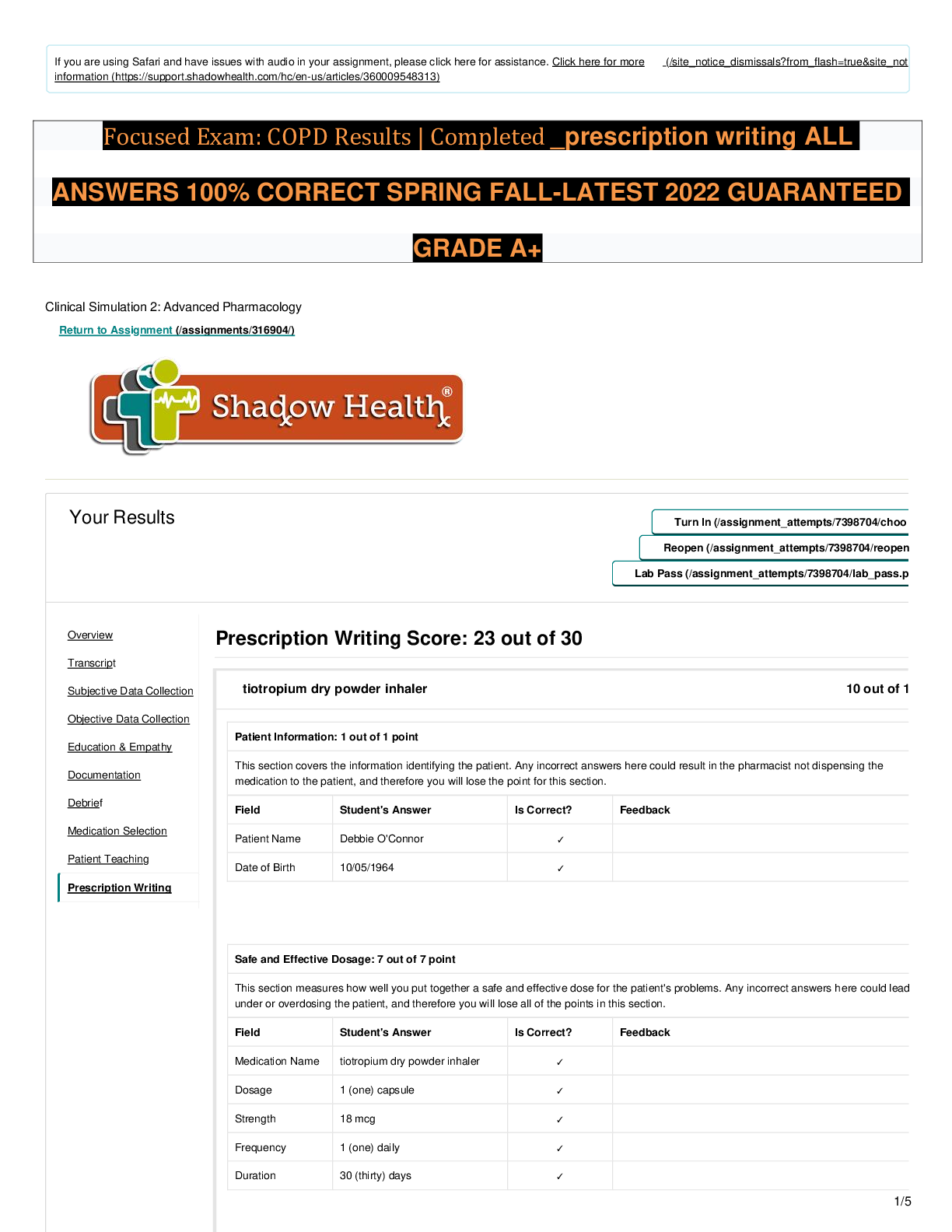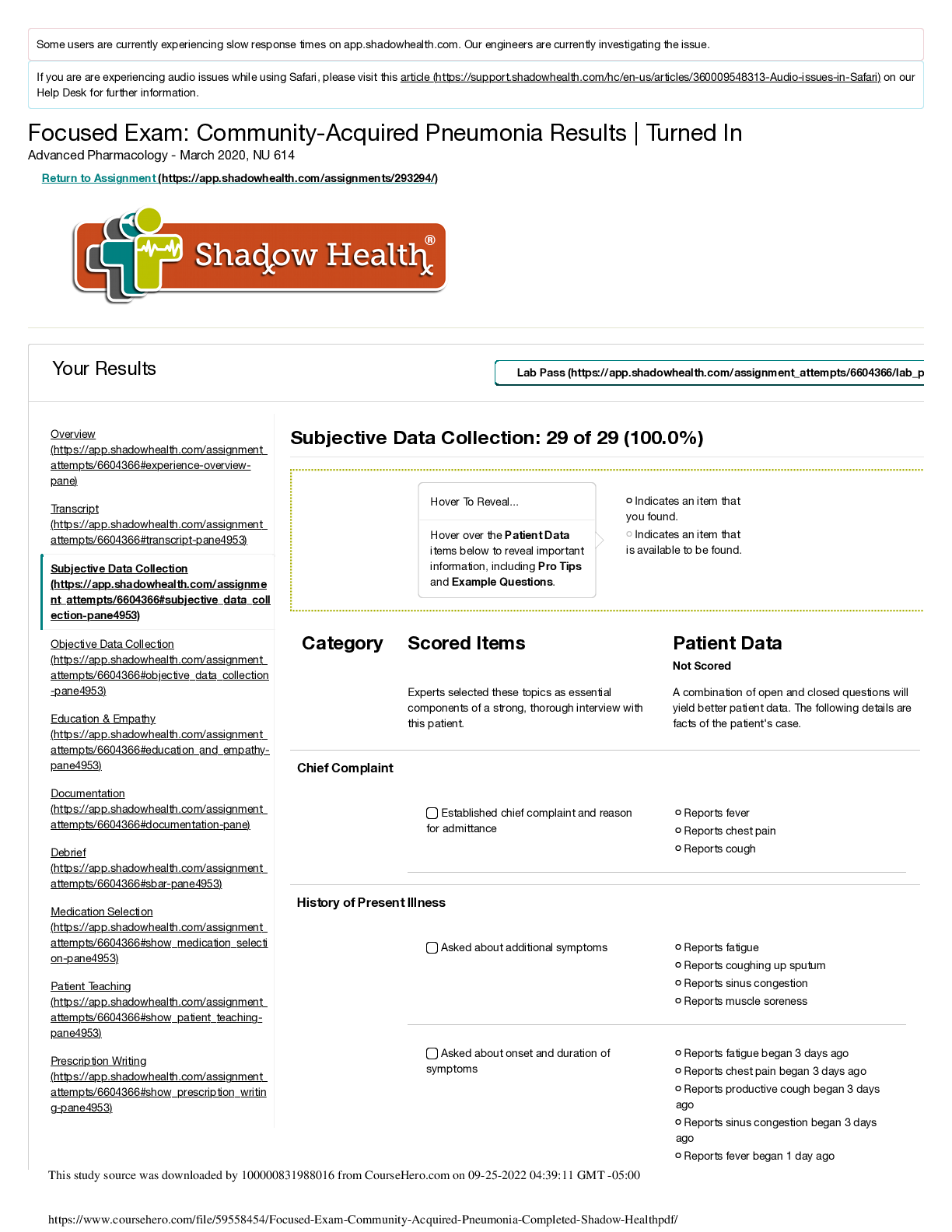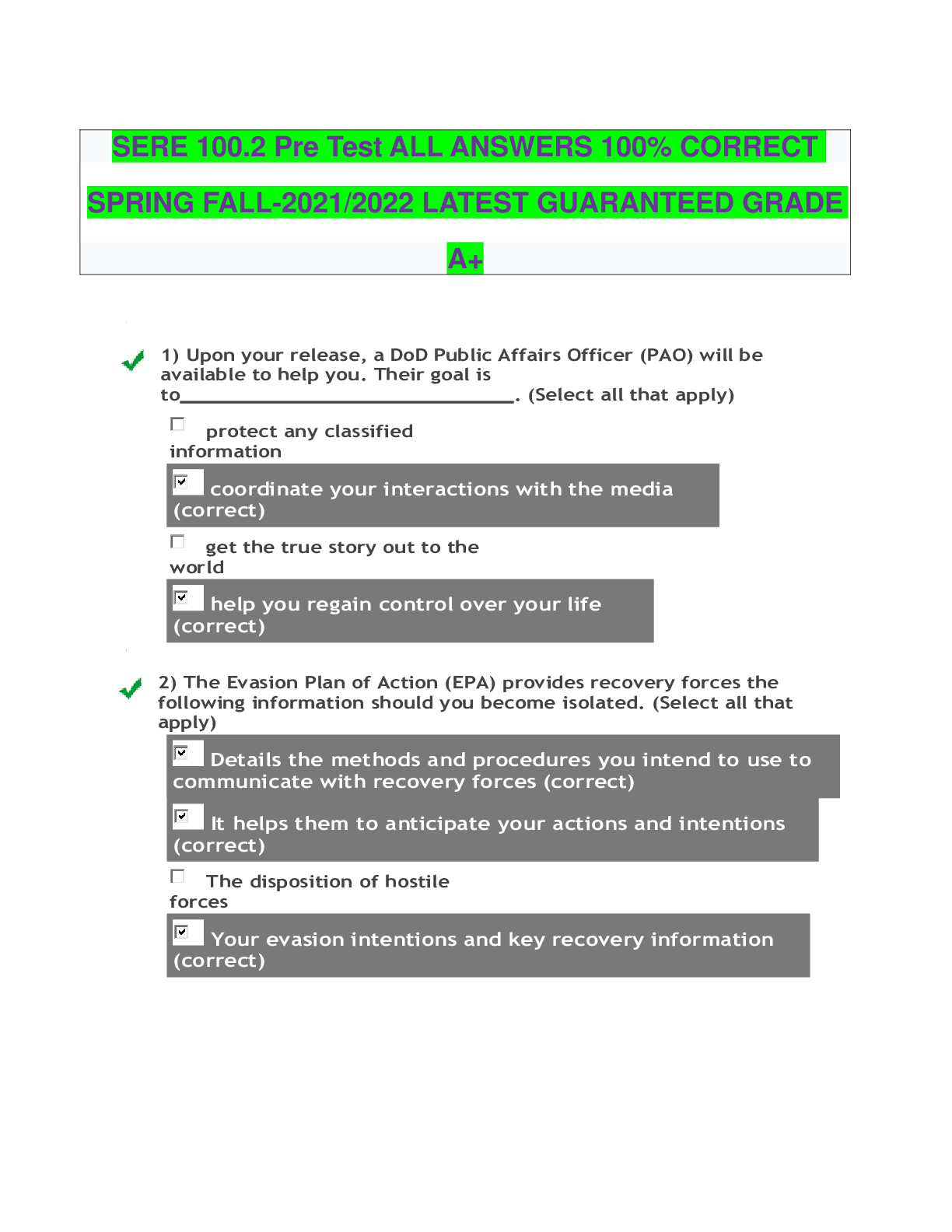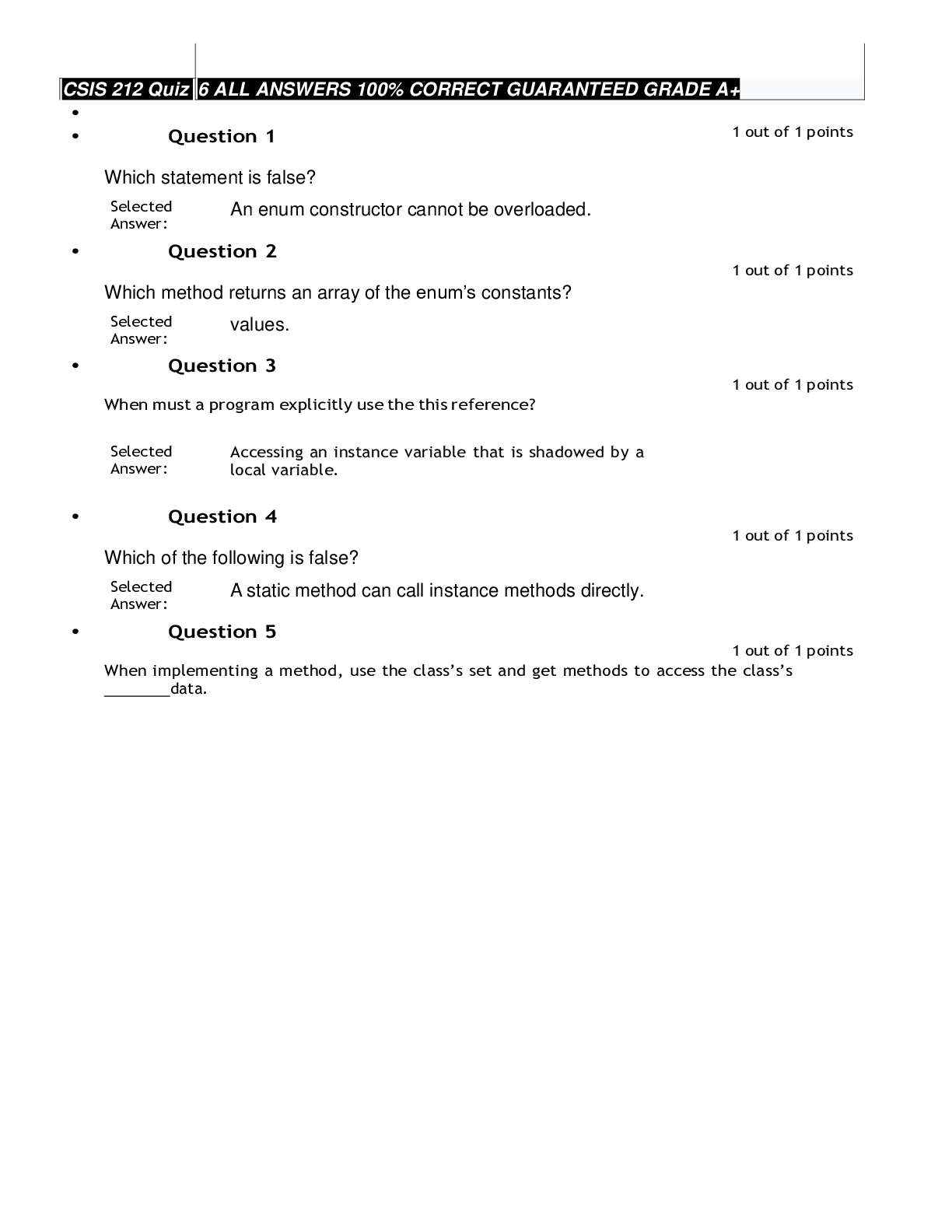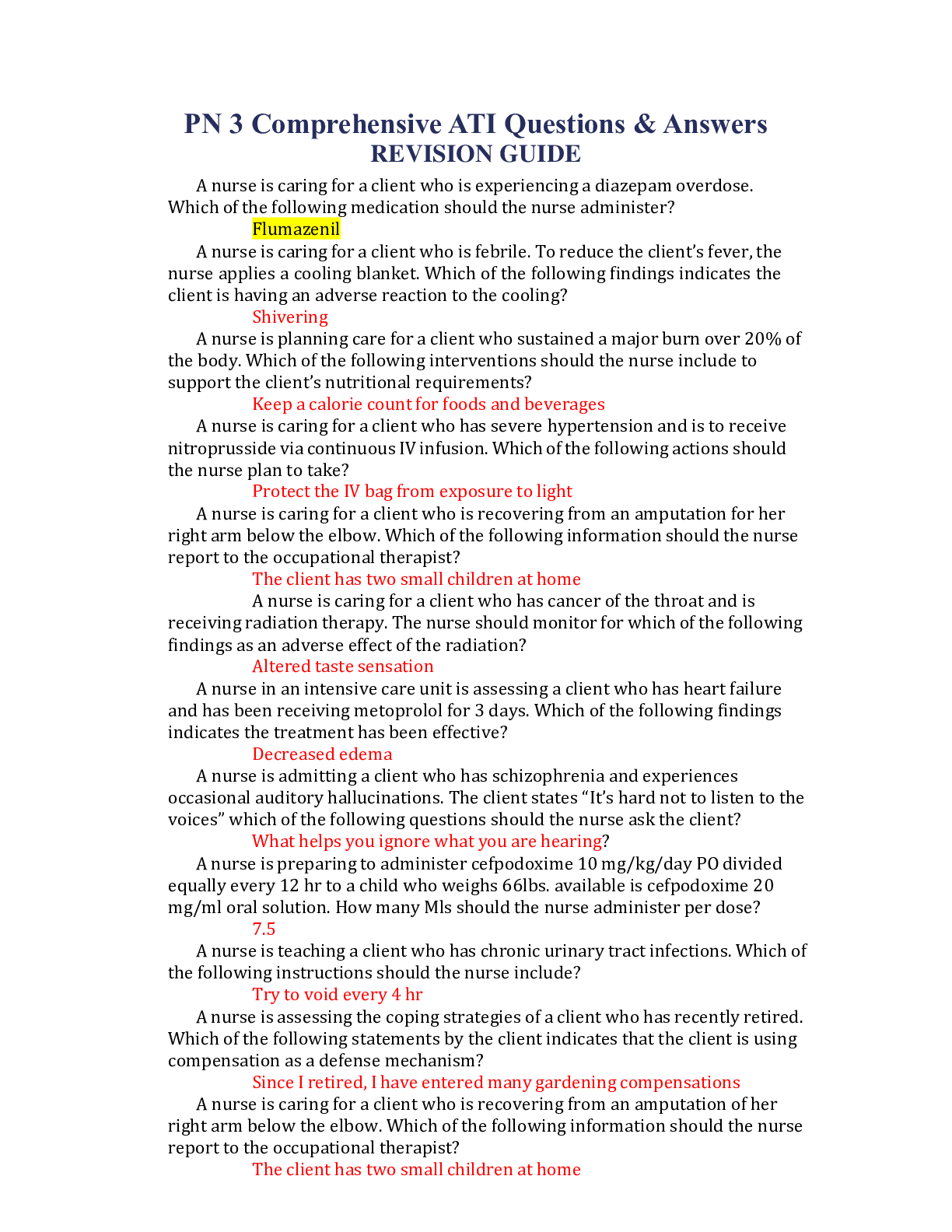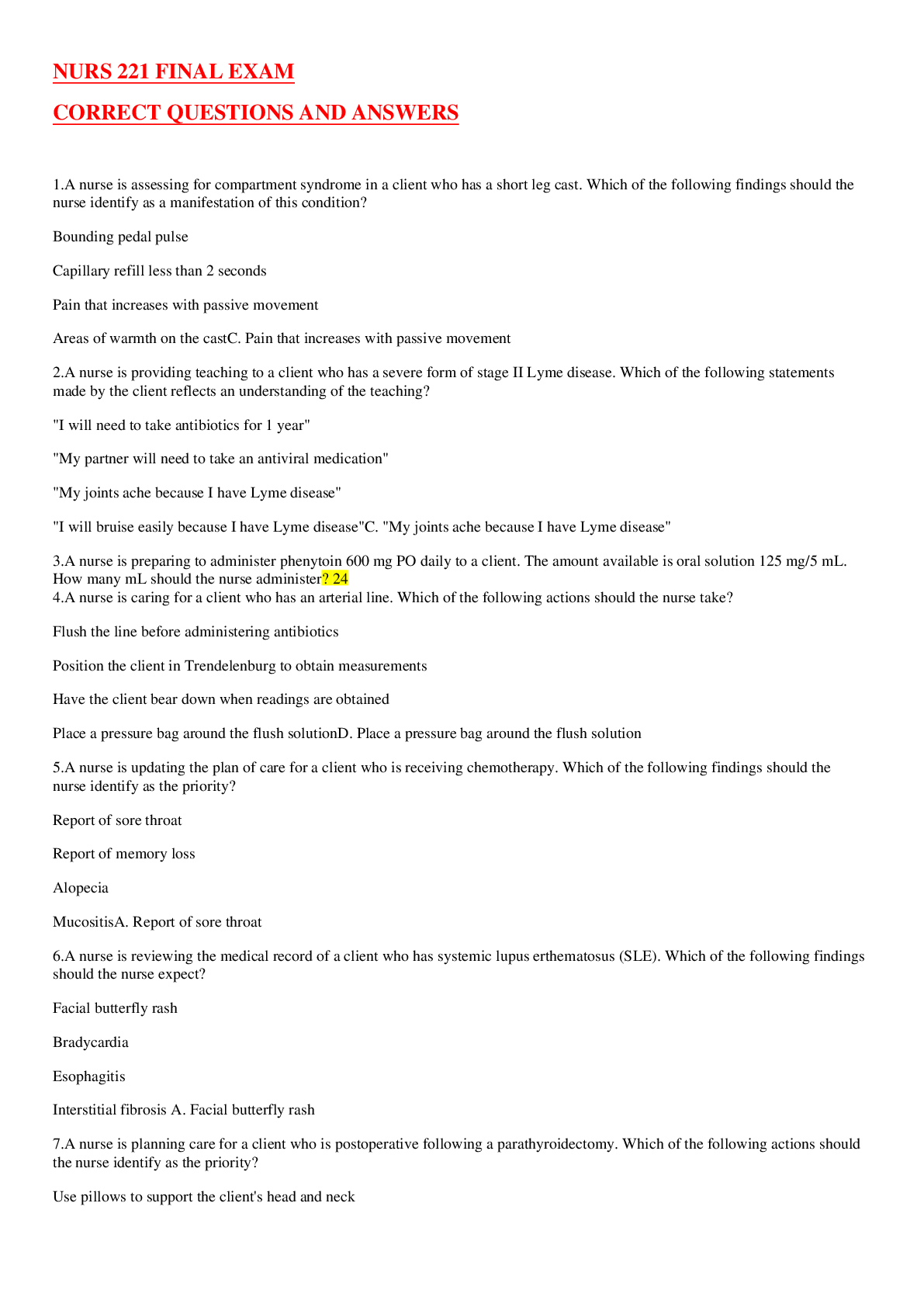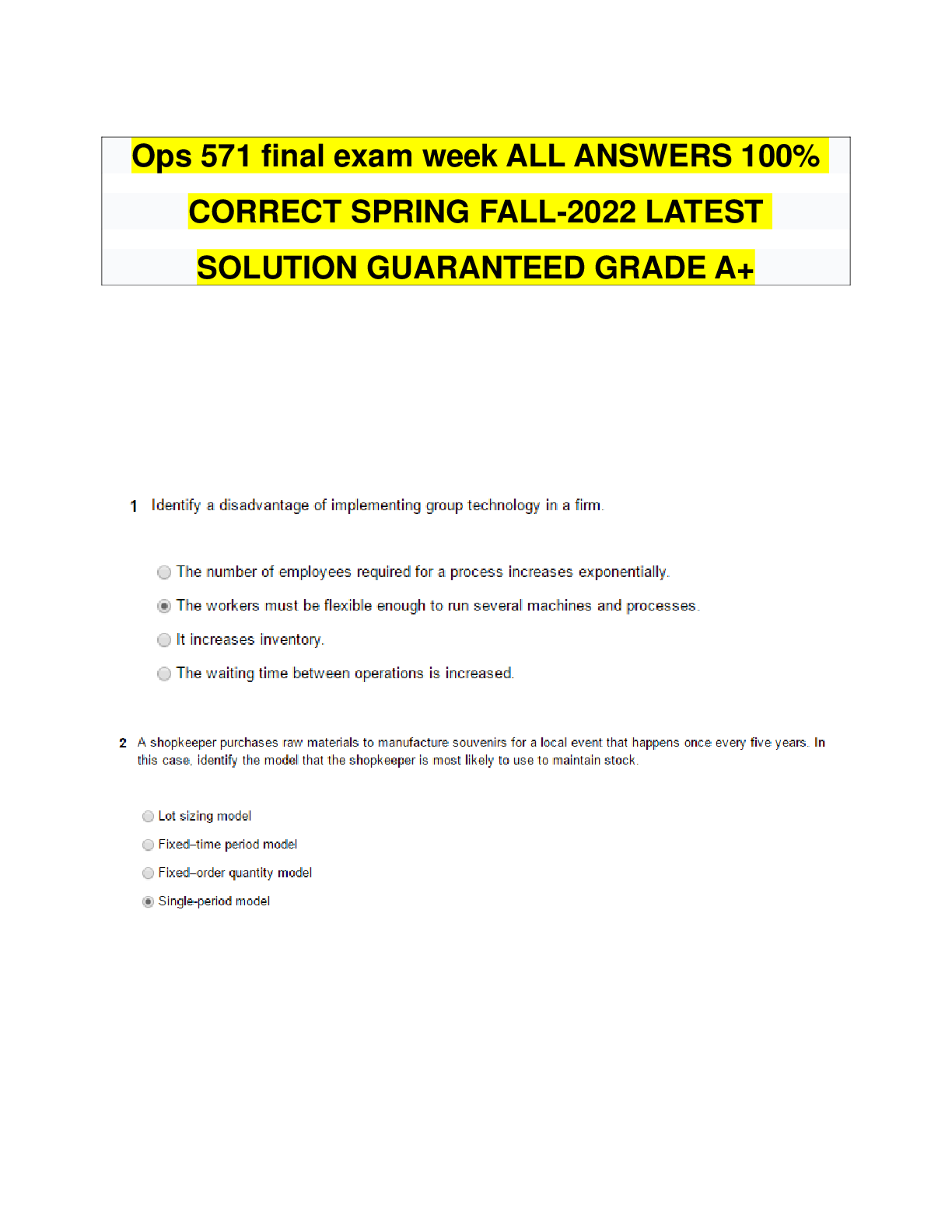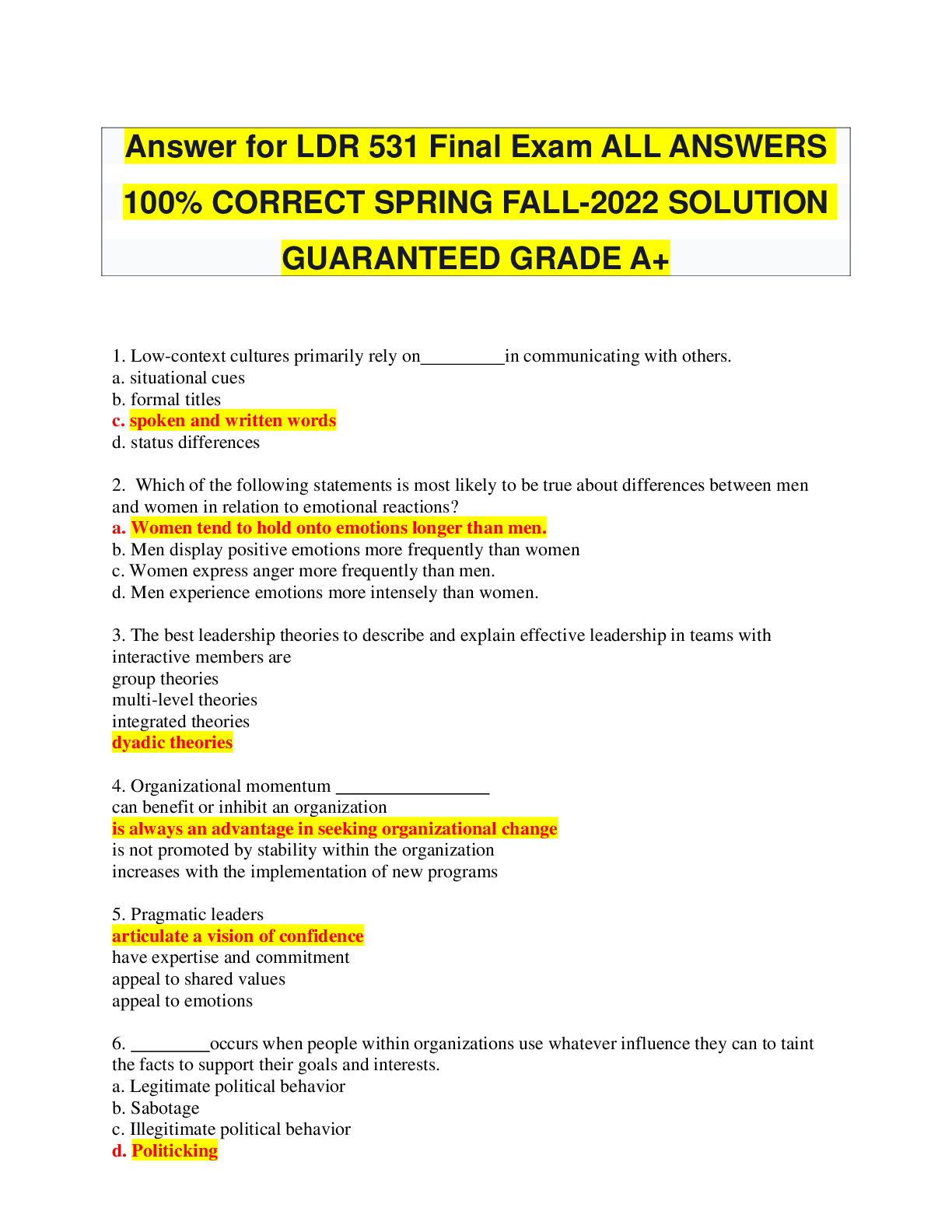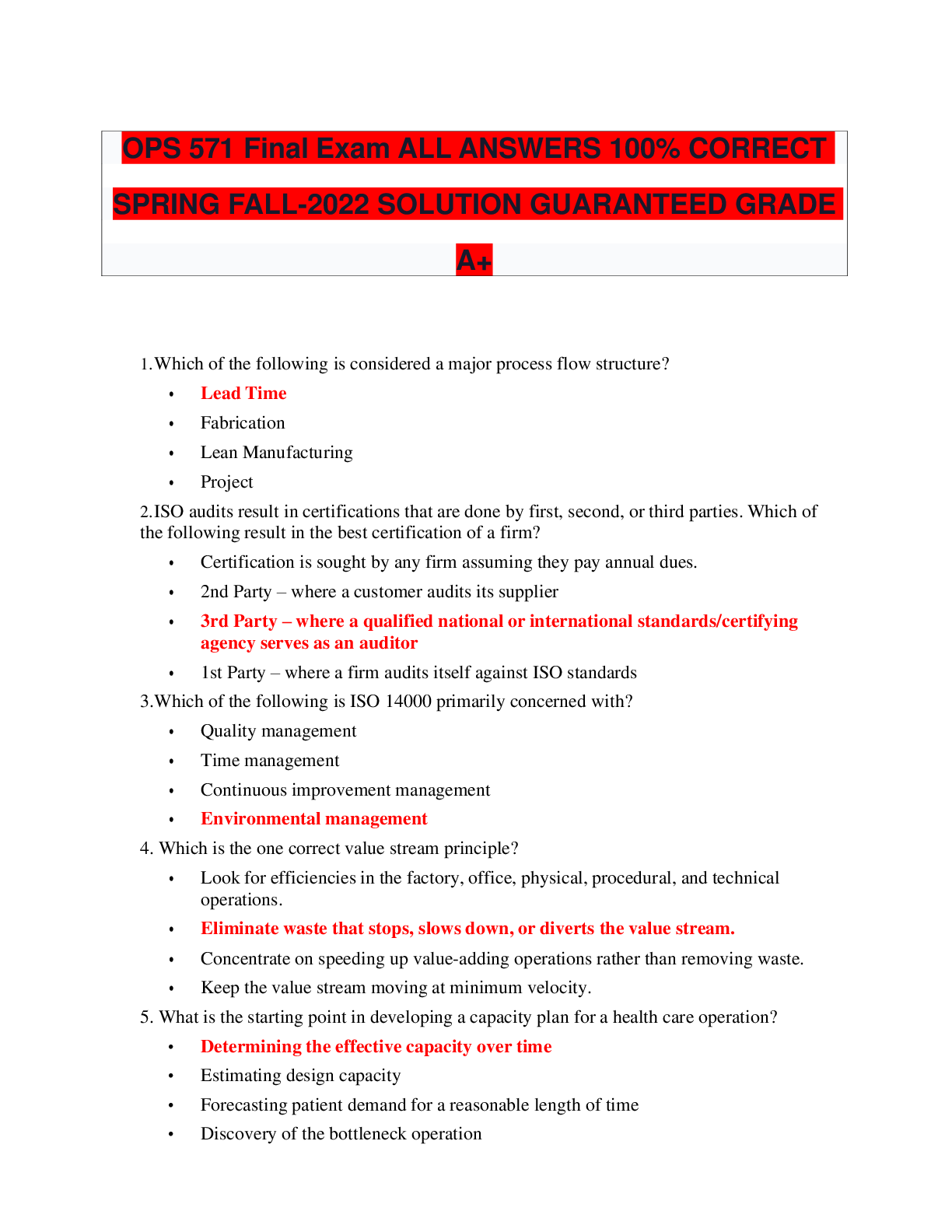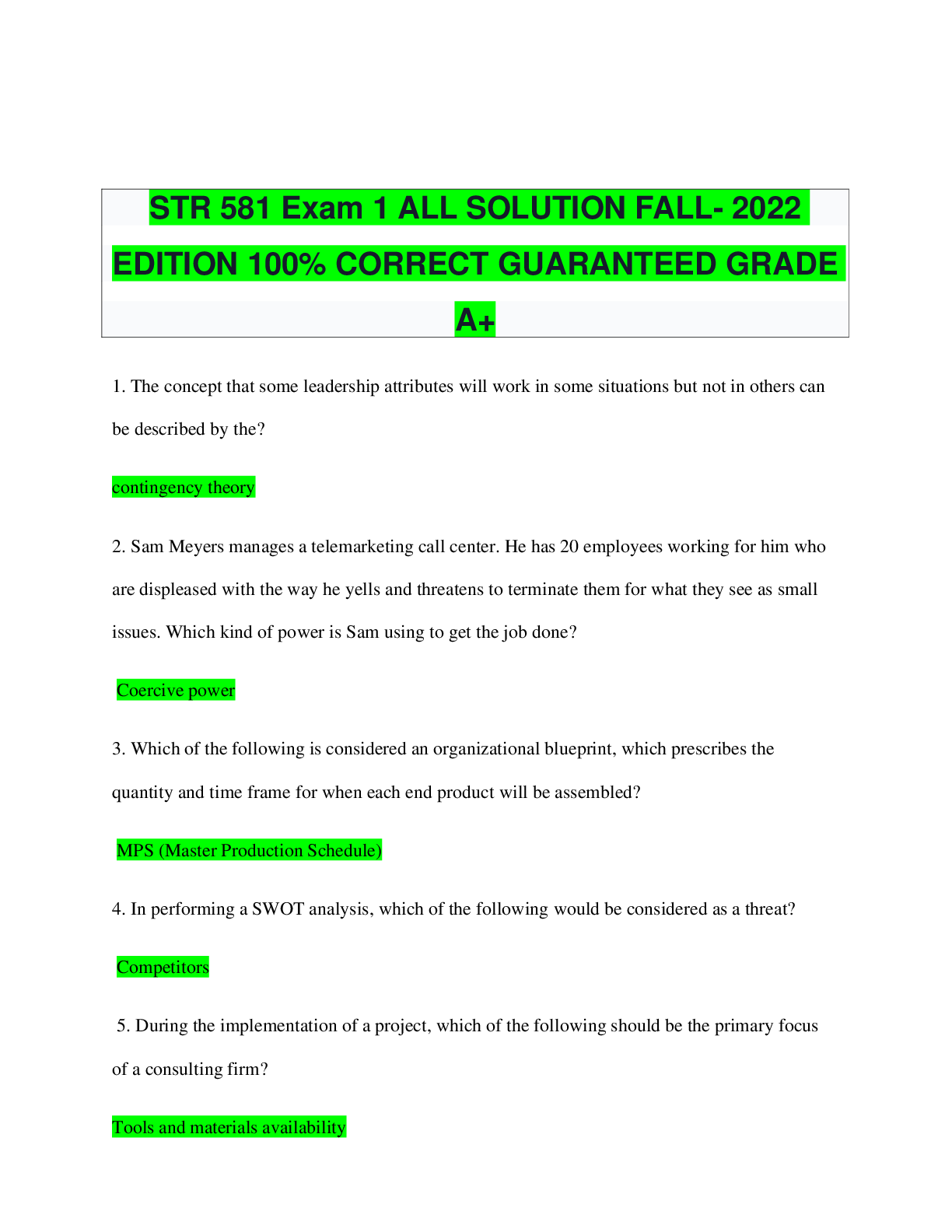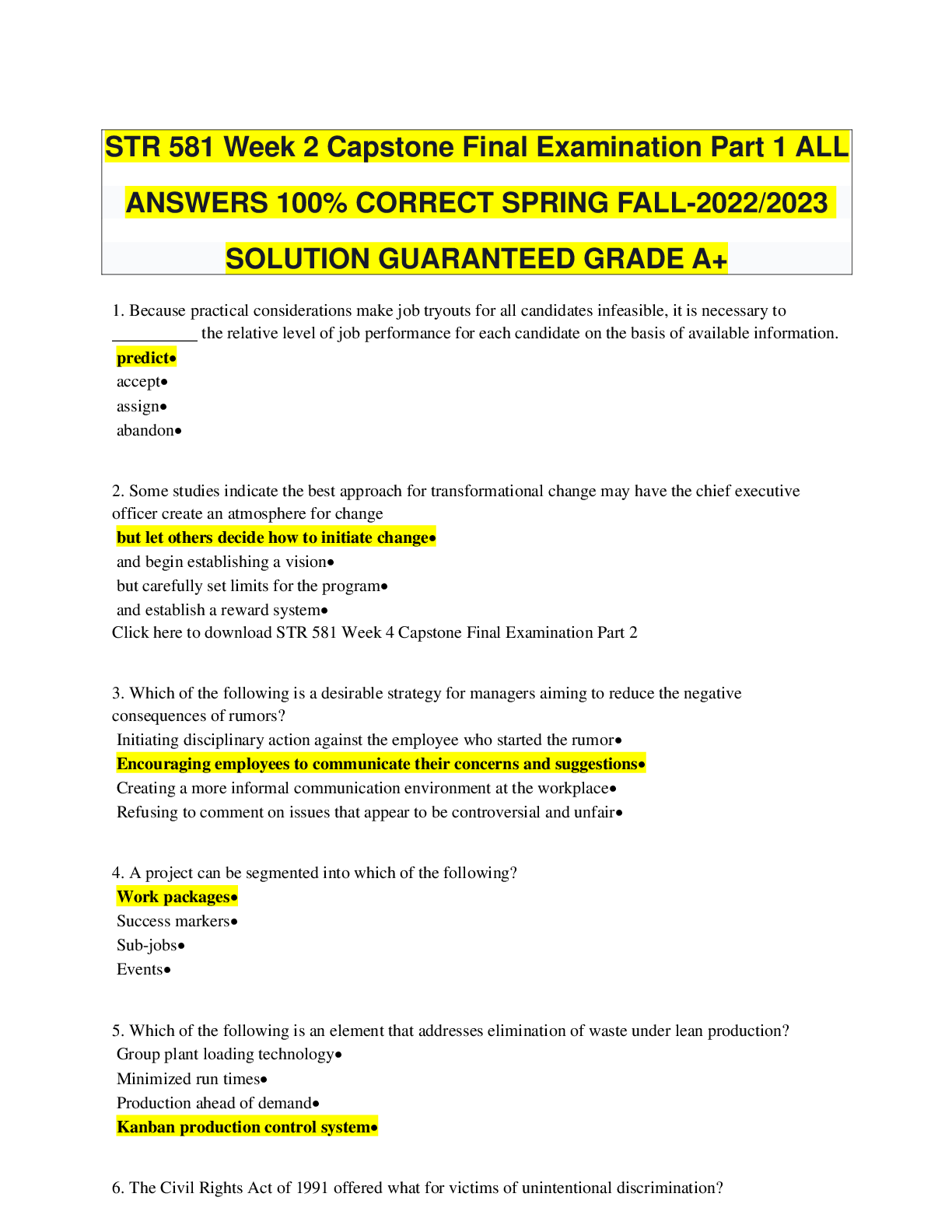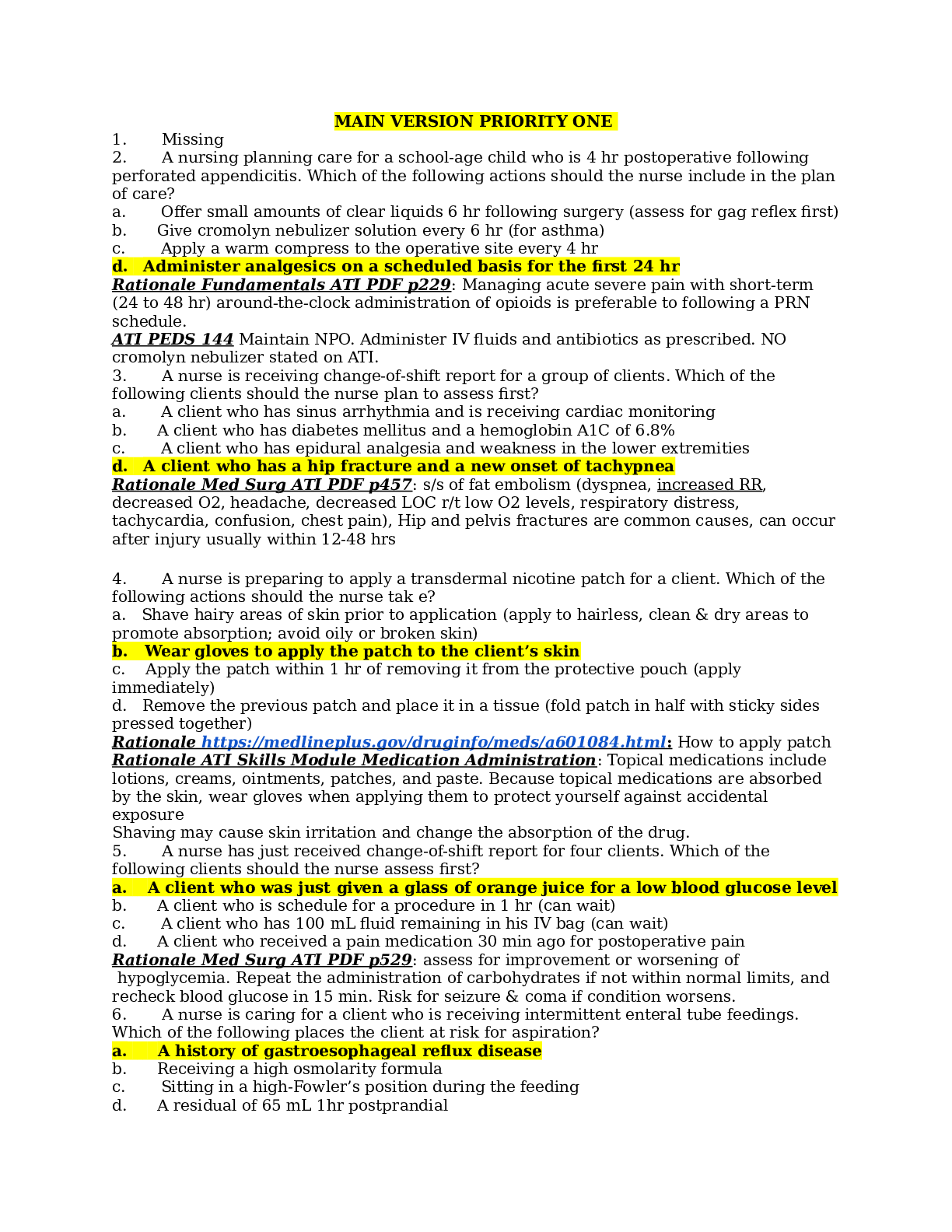ATI - RN Nutrition > EXAM > CNS Exam: Certified Nutrition Specialist LATEST EDITION QUESTIONS & ANSWERS 100% CORRECT 2024 UPDATE (All)
CNS Exam: Certified Nutrition Specialist LATEST EDITION QUESTIONS & ANSWERS 100% CORRECT 2024 UPDATE GUARANTEED GRADE A+
Document Content and Description Below
Dumping syndrome is associated with: A. Osmotic movement of water into the jejunum due to the presence of carbohydrate B. Reactive hypoglycemia C. Gastric resection surgery D. All of the above ... Answer: D - Dumping syndrome is associated with the movement of water into the jejunum due to the presence of carbohydrate. It often accompanies gastric resection surgery and leads to diarrhea. Reactive hypoglycemia may result when carbohydrate in the gut is rapidly digested and absorbed, leading to over-secretion of insulin. What do white specs in the nails indicate a deficiency in? zinc Q - Which of the following is a common side effect of immunosuppressive drug therapy used in organ transplantation? A. Sodium and fluid diuresis B. Hyperphosphatemia C. Hyperkalemia D. Decreased vitamin C requirements Answer: C - Hyperkalemia (elevated potassium levels) is a common side effect of immunosuppressive drug therapy used in organ transplantation, as a result of disturbances in renal hormone activity. Sodium and fluid retention and hypophosphatemia (electrolyte disturbance with abnormally low level of phosphate in the blood) are also side effects of immunosuppressive drugs. Q - Which of the following is true for reactive hypoglycemia? A. It is defined as a plasma glucose level less than 70 mg/dl. B. It is treated with a diet high in complex carbohydrates. C. It is diagnosed by measuring blood glucose levels one hour after eating. D. Peak insulin activity occurs 90-180 minutes after food is eaten. Answer: D - Initially after eating, blood glucose levels become dangerously low following a meal. In reactive hypoglycemia peak insulin activity occurs 90-180 minutes after food is eaten, vs. the normal insulin response which occurs 30-60 minutes after eating. Reactive hypoglycemia is defined as a plasma glucose level LESS than 50 mg/dl, is treated with a moderate carbohydrate (40 to 55%) diet, and is diagnosed by measuring blood glucose levels immediately after eating. Some critical illnesses can cause it--liver and kidney disorders. Q - Nutrient needs of infants diagnosed with bronchopulmonary dysplasia: A. Are linked with linear growth B. May include a resting energy expenditure 50% higher than that of normal infants C. May include use of diuretics to regulate water balance D. All of the above Answer: D - Nutrient needs of infants diagnosed with bronchopulmonary disease are linked with linear growth (a measure of lung development), may include a resting energy expenditure that is 50% higher than that of normal infants, and may include the use of diuretics to regulate water balance. Bronchopulmonary disease is a common lung disorder in premature infants which increases energy needs. Diuretics are often needed to regulate water balance as a result of respiratory compromise. Q - A food frequency questionnaire differs from a 24-hour recall in what way: A. A food frequency questionnaire does not inquire about portion sizes. B. The 24-hour recall asks about typical meal patterns. C. A food frequency questionnaire allows open-ended responses. D. A food frequency questionnaire always asks about the same types of foods. Answer: B - A food frequency questionnaire differs from a 24-hour recall because it does not ask about typical meal patterns. A food frequency questionnaire asks about intakes of different types of foods and usual portion sizes over time, and does not allow open-ended responses. The types of foods asked about on a food frequency questionnaire may be changed to reflect the population of interest. Q - Examples of foods avoided on a low-purine diet are: A. Eggs, cheese, peanut butter B. Sardines, broth, organ meats C. Carrots, tomatoes, corn D. Bread, crackers, cold cereal Answer: B - Examples of foods avoided on a low-purine diet are sardines, broth, and organ meats. These foods are high in purine and are eliminated in the treatment of gout, caused by high levels of uric acid in the blood. Purines (chemical compound found in some foods) are broken down into uric acid. Q - A 25-year old female patient recovering from surgery to correct an intestinal obstruction needs complete bowel rest which necessitates the use of Total Parenteral Nutrition (TPN). The patient was 10 pounds underweight prior to surgery and is occasionally febrile. Which of the following formulations would be most appropriate for this patient? A. 30 kcals, 1 g protein, 30 ml fluid per kg/body weight;100 mg vitamin C, 5 mg zinc per day B. 45 kcals, 2 g protein, 35 ml fluid per kg/body weight; 200 mg vitamin C, 6 mg zinc per day C. 60 kcals, 3 g protein, 40 ml fluid per kg/body weight; 500 mg vitamin C, 10 mg zinc per day D. None of the above Answer: B - The formula which would be most appropriate for this patient would contain 45 calories, 2 grams of protein, and 35 ml water per kg of body weight per day, as well as 200 mg of vitamin C and 6 mg of zinc. Starting with an intermediate level of caloric and protein intake, along with moderate vitamin C and zinc to promote healing, allows staff to monitor the patient's progress and determine if adjustment in the formula is needed. Q - Steatorrhea (FAT IN STOOL) may be caused by: A. Disruption in the activity of pancreatic enzymes B. Excessive production of bile salts by the liver C. Lack of intrinsic factor D. Intake of more than 70 grams of fat per day Answer: A - Steatorrhea may be caused by disruption in the activity of pancreatic enzymes that help to digest fat. It may also be caused by inadequate production of bile salts, which are needed for fat absorption. Q - Maple-syrup urine disease (MSUD) is an autosomal (chromosome) recessive disorder in infants caused by: A. The inability to metabolize branched-chain amino acids B. Plasma leucine levels exceeding 10 mg/dl C. A defect in the gene that controls the activity of alpha-keto acid hydrogenase D. A & C Answer: D - Maple-syrup urine disease (MSUD) in an autosomal recessive disorder in infants caused by the inability of the body to metabolize the branched-chain amino acids leucine, isoleucine, and valine. The inability to break down branched-chain amino acids is due to a mutation in the gene that controls the activity of the enzyme alpha-keto acid dehyrogenase. Plasma levels of leucine exceeding 10 mg/dl are associated with the symptoms of MSUD, including lethargy, vomiting, and neurologic changes. Q - Food intolerance is distinguished from food allergy in what way: A. Food intolerance is diagnosed by challenge tests. B. One of the causes of food intolerance is the passage of intact proteins across the gastrointestinal tract. C. There is no immunologic reaction with food intolerance. D. The body uses cellular immunity to combat food intolerance. Answer: C - Food intolerance is distinguished from food allergy by the lack of immunologic reaction, which involves release of an antibody in response to an antigen (allergen). Food allergy, not food intolerance, involves the reaction of the body's cellular immune system, and is often caused by the passage of intact proteins across the GI tract. Q - Cow's milk is unsuitable for infants less than a year of age due to: A. Large amounts of whey protein B. Inadequate fat content C. High cholesterol level D. High renal solute load Answer: D - Cow's milk is unsuitable for infants less than a year of age due to its high renal solute load, which stresses the infant's kidneys. The potential renal solute load (PRSL) of infant feedings is the sum of dietary nitrogen (expressed as mmol of urea, i.e., mg nitrogen divided by 28), sodium, potassium, chloride and phosphorus. Cow's milk contains casein protein, which is less digestible than whey, and its percentages of fat and cholesterol are not significantly different from that of breast milk. An effective nutrition screening program: A. Involves all members of the health care team who want to participate B. Is based on the principles of sensitivity and specificity C. Always uses food frequency questionnaires D. Is used only to screen for childhood diseases Answer: B - An effective nutrition screening program is based on the principles of sensitivity and specificity. Sensitivity helps ensure that a nutrition screening program picks up individuals at nutritional risk, while specificity helps to exclude individuals not at nutritional risk. Nutrition screening programs may use different types of tools to collect dietary information, and are used in populations of all ages, not just children. Which of the following nutrients produces an Respiratory Quotient (RQ) of 1.0, as measured by indirect calorimetry? A. Protein B. Fat C. Carbohydrate D. All of the above Answer: C - Carbohydrate produces an RQ (the ratio of CO2 produced to O2 consumed while food is being metabolized) of 1.0 using indirect calorimetry. This is because the number of molecules of carbon dioxide produced during carbohydrate metabolism is equal to the number of molecules of oxygen consumed. The Guthrie test is used to diagnose: A. Galactosemia B. Ornithine transcarboxylase deficiency C. Glycogen storage disease D. Phenylketonuria Answer: D - The Guthrie test is a blood assay used to diagnose phenylketonuria in newborn infants. It detects bacterial growth in an agar culture that is due to the presence of excess phenylalanine. Which of the following nutrients converts osteocalcin into its active form? A. Boron B. Calcium C. Magnesium D. Vitamin K Answer: D - Vitamin K Osteocalcin, also known as bone gamma-carboxyglutamic acid (GLA)-containing protein, is a noncollagenous protein hormone found in bone and dentin. Because it has GLA domains, its synthesis is vitamin K dependent. The lower the bone mass density, the greater the risk that the person will: A. develop osteoarthritis B. develop asthma C. develop COPD D. fracture a bone Answer: D - Fracture a bone Which of the following foods impairs calcification of bone in developing children? A. Beef B. Colas C. Green leafy vegetables D. Milk Answer: B - Colas List three specific nutrients that are recommended to build bone: Calcium, magnesium, phosphorus, vitamin D Neurotransmitter imbalances can affect sleep. Which of the following are the most logical approach to help to balance neurotransmitters? A. Calcium, magnesium, and potassium B. Melatonin and 5-HTP C. Multivitamin and exercise D. Vitamin D and Kava kava Answer: B - Melatonin and 5-HTP The most common herbs utilized for insomnia include all BUT the following: A. Comfrey B. Hops C. Passion flower D. Valerian Answer: A - Comfrey Red wine triggers migraine headaches more often than white whine because: A. Higher histamine content (20-200x higher) B. Higher levels of diamine oxidase (40-200x) C. Higher polyphenol and resveratrol content (3-6x higher) D. Lowers the release of vasoactive amines (4-12x) Answer: A - Higher histamine content (20-200x higher) Which of the following herbs has been associated with prevention of migraines: A. Dandelion root B. Ginkgo biloba C. Feverfew leaf D. Nettle leaf extract Answer: C - Feverfew leaf True or False: 70% of people with chronic daily headaches suffer from drug-induced headaches. True You have a client with a T-score of -2.7; therefore, the diagnosis would be: A. Anemia B. Hypocalcemia C. Osteoporosis D. Hypercalcemia Answer: C - Osteoporosis. A T-score of -1.0 or above is normal bone density. Bone is at maximum density in women: A. In her teens B. 30 C. 40 D. After menopause Answer: B - 30 About half of people with insomnia also are affected by: A. Alcoholism B. Depression and anxiety C. Irritable bowel syndrome D. Osteoporosis Answer: B - Depression and anxiety Adults require __________ hours of sleep each night. A. 3-4 hours B. 5-7 C. 7-9 D. 10-12 Answer: C - Adults require 7-9 hours of sleep You have a client who reports the feeling of tetany (a condition marked by intermittent muscular spasms, caused by malfunction of the parathyroid glands and a consequent deficiency of calcium) occurring in both the hands and feet. What is the likely cause of these symptoms? A. hypercalcemia B. dehydration C. hypocalcemia D. hyperkalemia Answer: A - Hypercalcemia Hypercalcemia is a condition in which the calcium level in your blood is above normal. Too much calcium in your blood can weaken your bones, create kidney stones, and interfere with the way your heart and brain works. Hypercalcemia most commonly results from overactive parathyroid glands. Every day toxins come into the body through which of the following ways: A. Air B. Food C. Skin D. Water E. All of the above Answer: E - All of the above - air, food, skin, water Construction materials, paint, and household cleaners have chemicals that: A. Are benign because they have been approved B. Make all of us sick C. Outgas chemicals into the air D. All of the above Answer: C - Outgas chemicals into the air The QEESI is: A. A diagnostic tool for Multiple Chemical Sensitivity B. A screening tool for Multiple Chemical Sensitivity C. A screening tool for exposure to chemicals D. Not a way to monitor Multiple Chemical Sensitivity E. Not to be used by patients in a clinical setting Answer: C - A screening tool for exposure to chemicals Liver detoxification programs pull out what substances primarily from the body? A. Protein substances B. Cholesterol and triglycerides C. Fat soluble chemicals D. Glycation end products Answer: C - Fat soluble chemicals The Detox Food Plan differs from the Elimination Diet in all but ONE of the following: A. It is designed to support the liver and digestive system B. It may involve adding medical food powders and supplements to enhance detoxification C. It places more emphasis on fermented and cultured foods D. It places stronger emphasis on eating clean foods life long and eating organic foods E. It uses food and detoxification to modulate hormones Answer: C - It places more emphasis on fermented and cultured foods The CP-450 phase of detoxification is: A. Excretory derivatives B. Intermediary metabolites C. Phase 1 D. Phase 2 Answer: C - Phase 1 Phase I metabolism results in small chemical changes that make a compound more hydrophilic, so it can be effectively eliminated by the kidneys. These reactions usually involve either adding or unmasking a hydroxyl group, or some other hydrophilic group such as an amine or sulphydryl group, and usually involve hydrolysis, oxidation or reduction mechanisms. Cytochrome P450 enzymes are responsible for most phase I reactions. Which of the following nutrients has its own detoxification pathway? A. Magnesium B. Sulfur C. Vitamin B12 D. Zinc Answer: B - Sulfur True or False: Eating cruciferous vegetables is a problem for most people with thyroid problems because they are goitrogens. Answer: False, not "most"; usually not an issue when cruciferous vegetables are cooked What is the term used to discuss chemicals that interfere with hormones? A. Endocrine agitators B. Endocrine corruptors C. Endocrine disruptors D. Endocrine disturbers Answer: C - Endocrine disruptors True or False: Endocrine disruptors can cause transgenerational changes. Answer: True Which of the following is NOT one of the three essential mechanisms of epigenetics: A. Chromatin sequencing B. DNA methylation C. Histone modification D. RNA interference Answer: A - Chromatin sequencing ChIP-sequencing, also known as ChIP-seq, is a method used to analyze protein interactions with DNA. The bioactive compounds in foods that have been best studied to date for their epigenetic effects are: A. Genistein and epigallocatechin-3-gallate B. Stilbenes such as resveratrol C. Proanthocyinadins and quercetins D. Tannins and phenolic acids Answer: A - Genistein and epigallocatechin-3-gallate One food that is specifically spotlighted as beneficial for detoxification is: A. Crucifers B. Eggs C. Cucumbers D. Soy Answer: D - Soy Which of the following gastrointestinal surgeries has the most detrimental effect on nutritional status? A. Jejunal resection B. Ileal resection C. Billroth I D. Billroth II Answer: B - Ileal resection, removal of part or all of the ileum, has the most detrimental effect on nutritional status because it causes decreased absorption of many nutrients, including fat-soluble vitamins, and interferes with bile salt activity needed for fat metabolism. In jejunal resection surgery, the ileum is able to compensate and take over some of the jejunum's absorptive functions. The Billroth I and Billroth II surgeries are gastric resections in which part of the stomach is removed for the purpose of promoting weight loss. In both of these surgeries the small intestine is able to compensate and handle activities related to digestion and absorption. Level Two of the National Dysphagia Diet permits which of the following foods? A. Crackers, toast, and baked potatoes B. Finely chopped cooked meats and soft-textured cooked vegetables C. Raw carrots, celery, and apple slices D. Chunky peanut butter, rice pudding, fruited yogurt Answer: B - Level Two of the National Dysphagia Diet permits finely minced or chopped cooked meats and soft-textured cooked vegetables. Level Two Dysphagia diet, also known as the Mechanical Altered Diet, is intended for use by those with minimal chewing ability. Raw fruits and vegetables as well as hard-to-chew foods and hard-to-swallow foods are prohibited. Children with fetal alcohol syndrome have the following facial trait: A. Ears that stand out B. Missing groove between upper lip and nose, thin upper lip C. Thicker than normal lips D. Wider than normal nose Answer: B. Missing groove between upper lip and nose, thin upper lip In the Parent Rating Summary by James Adams, the parents reported which treatment for autism as most effective? A. Antifungals (Diflucan/Nystatin) B. Behavior therapies C. Secretin D. Specific Carbohydrate Diet Answer: D. Specific Carbohydrate Diet (SCD) SCD is gluten free, but does not allow starch and sugar. SCD includes dairy that is virtually lactose free and contains denatured casein. However, dairy foods are not mandatory on SCD. Pam Ferro, of The Gottschall Autism Center and Hopewell Clinic, says the first three months for ASD children should be dairy free. According to Pizzorno/Murray, the incidence of ADD/ADHD in school age children is: A. <2% B. 2-5% C. 5-15% D. 15-25% Answer: C. 5-15% Which of the following is not a cause of autism? A. Heavy metals B. Leaky gut C. Maternal coldness toward her baby D. Neurotoxins E. Vitamin D insufficiency Answer: C. Maternal coldness toward her baby According to Pizzorno & Murray, when working with a child who has developmental issues, the logical starting point is: A. Behavioral therapies B. Clean up the diet of junk food, additives, sugar, refined flour and fried foods, while increasing nutrient density C. Fish oil supplementation D. Magnesium supplementation Answer: B. Clean up the diet of junk food, additives, sugar, refined flour and fried foods, while increasing nutrient density Which of the following medications has been associated with a risk for developing ADHD? A. Acetaminophen (Tylenol) B. Acetylsalicylic acid (aspirin) C. Ibuprofen (Motrin) D. Naproxen (Aleve) Answer: A. Acetaminophen (Tylenol) According to Krause, two of the dietary recommendations for ADHD include: A. Add magnesium rich foods and take a multimineral supplement B. Eliminate artificial dyes and add fish oil C. Eliminate eggs and take a multivitamin D. All of the above Answer: B. Eliminate artificial dyes and add fish oil The following nutrition diagnosis is written in what type of format: "Poor glycemic control is related to skipping use of oral hypoglycemic agents as evidenced by random blood glucose levels greater than 200 mg/dl". A. SOAP note B. POMR C. PES statement D. Continuity of care record Answer: C - The nutrition diagnosis "Poor glycemic control is related to skipping use of oral hypoglycemic agents as evidenced by random blood glucose levels greater than 200 mg/dl" is written as a PES statement (P is problem, E is etiology, S is signs or symptoms). Problem = poor glycemic control, Etiology = skipping use of oral hypoglycemic agents, S = blood glucose levels greater than 200 mg/dl. Which of the following is a characteristic of bulimia nervosa? A. The patient is of normal or near normal weight. B. The patient binges but does not purge. C. The patient does not have a body image problem. D. A typical binge lasts all day. Answer: A. The patient is of normal or near normal weight. Which of the following is often exhibited in patients with anorexia nervosa? A. Enamel wasting B. Esophagitis C. Muscle wasting D. Russell's sign Answer: C. Muscle wasting Which nutrient deficieny(ies) is/are most commonly associated with alcoholism? A. Vitamin A and caroteoids B. Folate and B6 C. Iron D. Magnesium Answer: B. Folate and B6 Which of the following nutrients can be used to reduce viral load in hepatitis? A. Vitamin A, 25,000 IU daily B. Vitamin B2 (riboflavin) 400 mg daily C. Vitamin C, 40-100 grams daily D. Magnesium 500-1,000 mg daily Answer: C. Vitamin C, 40-100 grams daily Vitamin C is the best antiviral all around. Which of the following are noted by Pizzorno to be beneficial to the liver? A. EPA/DHA supplementation B. Lipoic acid and silymarin C. Mushroom extracts and B-complex vitamins D. Vitamin E and vitamin D Answer: B. Lipoic acid and silymarin (milk thistle) Which of the following is a common sign of portal hypertension secondary to cirrhosis? A. Ascites B. Cardiac arrhythmias C. Increased gastrointestinal motility and peristalsis D. Pulmonary fibrosis Answer: A. Ascites - the accumulation of fluid in the peritoneal cavity, causing abdominal swelling. Which of the following recommendations should be included in the nutrition care plan for a patient in the acute post liver transplant phase? A. Calorie restriction B. Increased sodium C. Decreased protein D. Increased protein Answer: D. Increased protein In which eating disorder might a person chew and spit out, but not swallow, large amounts of food? A. Anorexia nervosa B. Bulimia nervosa C. Eating disorder not otherwise specified D. Binge-eating disorder Answer: A. Anorexia nervosa In which eating disorder might a person binge often but not try to compensate for this behavior? A. Anorexia nervosa B. Bulimia nervosa C. Eating disorder not otherwise specified D. Binge-eating disorder Answer: D. Binge-eating disorder Which type of immunosuppressant drug used in the treatment of liver transplant is most likely to promote sodium retention, hyperglycemia, and impaired absorption of calcium? A. Azathioprine B. Cyclosporine C. Glucocorticoid D. Tacrolimus Answer: C. Glucocorticoid Which of the following parameters is included in Subjective Global Assessment? A. Change in weight B. Nitrogen balance C. Fluid intake and output D. Liver enzyme levels Answer: A. Change in weight; Presented and described in detail is a clinical technique called subjective global assessment (SGA), which assesses nutritional status based on features of the history and physical examination. Illustrative cases are presented. When serum NH3 is high, which of the following medications is used to assist in lowering this level? A. Neomycin B. Lactulose C. Anti-NH3 metabolite D. Vitamin K Answer: B. Lactulose (prebiotic, encourages microbes to eat ammonia) Lactulose is a synthetic sugar used to treat constipation. It is broken down in the colon into products that pull water out from the body and into the colon. This water softens stools. Lactulose is also used to reduce the amount of ammonia in the blood of patients with liver disease. You have a new client who suffers from anxiety and depression, the first thing you do is: A. Put your client on a ketogenic diet B. Recommend St. John's Wort C. Recommend vitamin D testing D. Use the Functional Medicine Matrix and Timeline to gather information" Answer: D. Use Functional Medicine Matrix and Timeline to gather information List 3 affective disorders Depression, bipolar disorder, anxiety Affective disorders are a set of psychiatric diseases, also called mood disorders. The main types of affective disorders are depression, bipolar disorder, and anxiety disorder. Symptoms vary by individual, and can range from mild to severe. According to Pizzorno and Murray, in people who are diagnosed with moderate depression, use of SSRI medication: A. is equivalent to placebo B. Is less effective than placebo C. Is better than placebo for all patients Answer: A. Is equivalent to placebo You have a new client who is depressed. Which of the following has been reported in the research to be the most effective anti-depressant? A. An elimination diet B. Exercise C. S-adenosyl-methionline D. Vitamin B12 and folate Answer: B. Exercise Which nutrient was taken off of the market for more than 30 years due to a contaminated batch, which caused eosinophilia-myalgia syndrome? A. 5-HTP B. L-tryptophan C. Phenylalanine D. Tyrosine Answer: B. L-tryptophan Which of the following supplements is best absorbed to raise serum serotonin levels? A. 5-HTP B. L-tryptophan C. Melatonin D. SAMe E. Serotonin Answer: A. 5-HTP When working with someone with mental health issues, it is best to: A. Work alone B. Work as part of a team C. Either works equally well Answer: B. Work as part of a team Which of the following is important to consider when someone suffers from mental illness? A. Diet B. Environmental contaminants C. Hormone balance D. Lifestyle E. All of the above Answer: E. All of the above The primary responsibility of a nutritionist working with people who have a mental health diagnosis is to: A. Minimize food-nutrient interactions B. Prevent malnutrition C. Provide information and support for eating choices that minimize negative impacts of the disorder D. Recommend nutritional supplements E. Recommend testing Answer: C. Provide information and support for eating choices that minimize negative impacts of the disorder When Omega 3 or LCFA supplementation is used, what else should be provided with the supplement? A. Increased fiber B. Increased fluid C. Vitamin E D. Vitamin C Answer: C. Vitamin E A medication which needs to be discontinued in a uremic patient is: A. Epogen B. Kayexelate C. Humulin D. Triamterene Answer: D - A medication which may need to be discontinued in uremia is Triamterene, a potassium-sparing diuretic. Because serum potassium levels are high in uremia, use of potassium-sparing diuretics such as Triamterene is contraindicated. Epogen stimulates red blood cell production, Kayexelate is a potassium-binder, and Humulin is synthetic insulin, all of which may be indicated for use in uremia. Stomatitis is treated with which of the following dietary interventions? A. Supplementation with iron B. Clear liquid diet C. Avoidance of acidic and spicy foods D. A & C Answer: D - Stomatitis is an inflammation of the mucous membranes of the mouth. It may be caused by iron deficiency, in which case it is treated with iron supplementation. The usual dietary regimen is avoidance of acidic and spicy foods. Antidiuretic hormone (ADH) is released in response to: A. Decreased serum osmolality B. Increased serum osmolality C. Decreased urinary urea nitrogen D. Increased urinary urea nitrogen Answer: B - Antidiuretic hormone (ADH) is released in response to increased serum osmolality (concentration). ADH promotes retention of water by the kidneys, in response to increased osmolality, which causes increases the solute content of the blood. The usual dietary treatment for cholecystitis is: A. Restriction of foods that stimulate pancreatic enzymes B. 20% fat diet with MCT supplementation C. 25% fat diet with fat-soluble vitamin supplementation D. Lowering cholesterol intake to less than 300 mg/day Answer: C - The usual treatment for cholecystitis is a 25% fat diet with fat-soluble vitamin supplementation. Cholecystitis is inflammation of the gall bladder, usually caused by the accumulation of bile due to blockage of the bile duct or gallstone formation. Lower fat restriction is not used because some fat is needed to stimulate gallbladder constriction and drainage of bile. Which of the following vitamins functions as a hormone? A. Folic acid B. Vitamin C C. Vitamin E D. Vitamin D Answer: D - Vitamin D functions in the form calcitriol as a hormone in the regulation of body calcium and phosphorus. It is also responsible for the formation of bone. Which of the following is true for athletic amenorrhea, the loss of menstrual periods caused by excessive exercise? A. It results in irreversible bone loss B. It may be successfully treated by increasing carbohydrate intake C. It is treated by decreasing the intensity and amount of exercise D. A & C Answer: D - Athletic amenorrhea, the loss of menstrual periods caused by excessive exercise, results in irreversible bone loss, and is treated by decreasing the intensity and amount of exercise. It is not helped by increasing intake of carbohydrates. The National Health and Nutrition Examination Survey (NHANES) has which of the following objectives? A. Ongoing collection of health data from Americans < 65 years of age B. Identification of low birth weight infants C. Treatment for elevated blood lipid levels D. Collection of dietary data using 24-hour recalls Answer: D - The National Health and Nutrition Examination Survey (NHANES) collects dietary data using 24-hour recalls, from Americans aged 2 months to 65+ years of age. NHANES objectives do not include identification of low birth weight infants or treatment for elevated lipid levels. Clinical signs of cirrhosis of the liver are: A. Ascites and hypoalbuminemia B. Portal hypotension and constriction of esophageal veins C. Fat malabsorption and hyponatremia D. Decreased hepatic plasma volume and high osmolality Answer: A - Clinical signs of cirrhosis of the liver are ascites (abdominal edema) and hypoalbuminemia, resulting from the replacement of healthy liver cells with fibrous connective tissue. This buildup of abnormal tissue disrupts normal blood flow, eventually leading to portal hypertension, expansion of esophageal veins, hypernatremia, and increased hepatic plasma volume. The end result of these changes is decreased serum albumin and fat malabsorption, with eventual nutrient deficiencies. A 16-year old teenage girl with Type I diabetes seeks counseling for erratic blood glucose levels. She is on the school track team and works out in the afternoons for 1 ½ hours. Her meal plan consists of 3 meals, a pre-exercise snack of one fruit, and a bedtime snack of ½ cup cereal and 1 cup of milk. Her insulin regimen is 3 units of regular insulin before breakfast and 2 units of regular insulin before dinner, and equal amounts of NPH mid-morning and at bedtime. Lately her pre-dinner blood glucose levels have been low. What would be the most effective nutrition intervention for her? A. Reduce the mid-morning NPH insulin by one unit and add a protein exchange to the afternoon snack. B. Increase the bedtime insulin and add another bread exchange to the bedtime snack. C. Reduce the afternoon exercise to 45 minutes and have her carry fruit juice with her in case she feels dizzy or weak. D. A & B Answer: A - The most effective intervention would be to reduce the mid-morning NPH insulin by one unit and add protein exchange to the afternoon snack. NPH is an intermediate-acting insulin which has its peak effect in the afternoon. Reducing the amount of NPH by one unit and adding protein to the pre-exercise snack will help eliminate low blood glucose levels before the evening meal. Brown adipose tissue performs what function in the body: A. Protects internal organs from injury B. Storage site for triglycerides C. Is considered to be "essential fat" that supports metabolic processes D. Heat production and regulation of body temperature Answer: D - Brown adipose tissue is believed to regulate heat production and body temperature, particularly in infants who are susceptible to hypothermia. White adipose tissue is the major type of fat in the body. It protects internal organs from injury, stores triglycerides, and makes up the essential fat that supports many metabolic processes. Which of the following is not included in extracellular water (or extracellular fluid, ECF)? A. Plasma B. Lymph C. Metabolic water D. Spinal fluid Answer: C - Metabolic water, the water produced by the digestion and absorption of food, is not included in extracellular fluid, which is composed of plasma, lymph, and spinal fluid, as well as water from secretions. Parkinson's disease is characterized as a progress loss of: A. Serotonin B. Acetylcholine C. Dopamine D. Nitric oxide Answer: C. Dopamine Which of the following amino acid-derived neurotransmitters is linked to the etiology of ALS (Lou Gehrig's disease)? A. Tyrosine B. Arginine C. Tryptophan D. Glutamate Answer: D. Glutamate; Glutamate is a neurotransmitter that sends signals in the brain and throughout the nerves in the body. Glutamate plays an important role during brain development. Normal levels of glutamate also help with learning and memory. Having too much glutamate in the brain has been associated with neurological diseases such as Parkinson's disease, multiple sclerosis, Alzheimer's disease, stroke, and ALS (amyotrophic lateral sclerosis or Lou Gehrig's disease). Problems in making or using glutamate have also been linked to a number of mental health disorders, including autism, schizophrenia, depression, and obsessive-compulsive disorder (OCD). Research in the early 1990s determined that ALS patients have raised levels of glutamate in the fluid bathing the brain and spinal cord. In fact, 40 percent of sporadic cases of ALS are characterized by this elevated glutamate in cerebrospinal fluid (CSF). Abundant evidence points to glutamate as a destructive factor in ALS. The first and so far only approved specific treatment for ALS is riluzole, a drug that modulates glutamate. A patient with MS has been treated with corticosteroids long term. What nutrition intervention is appropriate? A. Supplementation with vitamin D and calcium B. Increasing complex carb intake C. Supplementation with antioxidants D. Promoting the Atkins diet Answer: A. Supplementation with vitamin D and calcium. What is unique about Dr. Bredesen's approach to treat Alzheimer's disease? Answer: It is personalized. Requires long-term compliance. It relies on assistance from family/friends. It looks at nutrition and cholesterol. In Alzheimer's disease, which of the following statements is most true: A. Patients have an accumulation of Beta-amyloid and neurofibrillary tangles B. Patients have elevated C-reactive protein and fibrinogen levels C. Patients have normal homocysteine levels and methylation defects D. Patients have normal hemoglobin A1C and fasting insulin levels Answer: A. Patients have an accumulation of Beta-amyloid and neurofibrillary tangles The gene single nucleotide polymorphisms (SNP) most closely associated with Alzheimer's disease is: A. APO-E4 B. C677-TT C. COMT D. MAO Answer: A. APO-E4 Apolipoprotein E is a class of apolipoprotein found in the chylomicron and Intermediate-density lipoprotein that is essential for the normal catabolism of triglyceride-rich lipoprotein constituents. Currently, the APOE gene (located on chromosome 19) is the only gene identified that is related to LOAD (late onset Alzheimer's disease), and it also runs in families, although its relation to the occurrence of LOAD is weak. APOE at the molecular level helps in the synthesis of apolipoprotein E, which is a cholesterol carrier in the brain, helping in amyloid aggregation and the clearing of deposits from the parenchyma of the brain. In the absence of function of this gene, excessive beta-amyloid deposits occur in the brain, which is one of the findings in patients with LOAD. There are different forms, or alleles, of APOE, with the 3 most common ones being APOE ε2, APOE ε3, and APOE ε4. True or False: Neurological problems such as MS, Parkinson's, and ALS are all considered to be autoimmune conditions. True An autoimmune disease develops when your immune system, which defends your body against disease, decides your healthy cells are foreign. As a result, your immune system attacks healthy cells. Depending on the type, an autoimmune disease can affect one or many different types of body tissue. Most common types: rheumatoid arthritis, lupus, celiac disease, Sjogren's syndrome, multiple sclerosis, ankylosing spondylitis, type 1 diabetes, alopecia areata. Which of the following is most true about Multiple Sclerosis: A. Current research indicates that MS is really Lyme disease B. It is a condition of demylenization of the nerve sheath C. It is due to a decline in L-dopa D. Multiple sclerosis is not affected by season or latitude and longitude Answer: B. It is a condition of demylenization of the nerve sheath Which of the following neurological conditions is most closely associated with gait problems that cause people to take tiny steps? A. Amyotrophic Lateral Sclerosis B. Multiple Sclerosis C. Parkinson's Disease Answer: C. Parkinson's Disease True or False: Parkinson's disease has been associated with environmental insults, such as pesticides and rotenone. Answer: True Which of the following nutrition assessment methods is used to collect dietary information from a community? A. Food record B. 24-hour recall C. Food frequency questionnaire D. Diet history Answer: C - A food frequency questionnaire is the nutrition assessment method used to collect dietary information from a community, since validation studies have shown that it provides the best estimate of the nutrient intake of a group. The dietary treatment which may be most effective for symptoms of polycystic ovary syndrome (PCOS) is: A. Low glycemic index diet and supplementation with omega-3 fatty acids B. Vegan diet with vitamin B12 supplementation C. 1200-calorie diet to promote weight loss D. Low-salt diet with increased intake of potassium-rich fruits and vegetables Answer: A - The dietary treatment which may be most effective for reducing the symptoms of polycystic ovary syndrome is a low glycemic index diet with omega-3 fatty acid supplementation. PCOS is a common endocrine disorder in teenage girls that is characterized by weight gain and abnormal blood sugar levels. Eating a diet based on low glycemic index foods helps to stabilize blood sugar, and omega-3 fatty acids can help regulate hormone levels. A food frequency questionnaire differs from a 24-hour recall in what way: A. A food frequency questionnaire does not inquire about portion sizes. B. The 24-hour recall asks about typical meal patterns. C. A food frequency questionnaire allows open-ended responses. D. A food frequency questionnaire always asks about the same types of foods. Answer: B - A food frequency questionnaire differs from a 24-hour recall because it does not ask about typical meal patterns. A food frequency questionnaire asks about intakes of different types of foods and usual portion sizes over time, and does not allow open-ended responses. The types of foods asked about on a food frequency questionnaire may be changed to reflect the population of interest. Nutrient needs of infants diagnosed with bronchopulmonary dysplasia: A. Are linked with linear growth B. May include a resting energy expenditure 50% higher than that of normal infants C. May include use of diuretics to regulate water balance D. All of the above Answer: D - Nutrient needs of infants diagnosed with bronchopulmonary disease are linked with linear growth (a measure of lung development), may include a resting energy expenditure that is 50% higher than that of normal infants, and may include the use of diuretics to regulate water balance. Bronchopulmonary disease is a common lung disorder in premature infants which increases energy needs. Diuretics are often needed to regulate water balance as a result of respiratory compromise. Which of the following is true for reactive hypoglycemia? A. It is defined as a plasma glucose level less than 70 mg/dl. B. It is treated with a diet high in complex carbohydrates. C. It is diagnosed by measuring blood glucose levels one hour after eating. D. Peak insulin activity occurs 90-180 minutes after food is eaten. Answer: D - In reactive hypoglycemia peak insulin activity occurs 90-180 minutes after food is eaten, vs. the normal insulin response which occurs 30-60 minutes after eating. Reactive hypoglycemia is defined as a plasma glucose level than 50 mg/dl, is treated with a moderate carbohydrate (40 to 55%) diet, and is diagnosed by measuring blood glucose levels immediately after eating. Which of the following is a common side effect of immunosuppressive drug therapy used in organ transplantation? A. Sodium and fluid diuresis B. Hyperphosphatemia C. Hyperkalemia D. Decreased vitamin C requirements Answer: C - Hyperkalemia (elevated potassium levels) is a common side effect of immunosuppressive drug therapy used in organ transplantation, as a result of disturbances in renal hormone activity. Sodium and fluid retention and hypophosphatemia are also side effects of immunosuppressive drugs. Potassium is a nutrient critical to the function of nerve and muscle cells, including those in your heart. Blood potassium level is normally 3.6 to 5.2 millimoles per liter (mmol/L). Diets rich in omega-3 fatty acids reduce the inflammation of arthritis through the action of which intermediary: A. Corticosteroids B. Prostaglandin 3 C. Arachidonic acid D. Ganglioside Answer: B - Diets rich in omega-3 fatty acids reduce the inflammation of arthritis through the action of prostaglandin 3, an intermediary compound formed in omega-3 metabolism. Arachidonic acid is an omega-6 fatty acid which forms prostaglandin 2, responsible for increased inflammation. Examples of foods avoided on a low-purine diet are: A. Eggs, cheese, peanut butter B. Sardines, broth, organ meats C. Carrots, tomatoes, corn D. Bread, crackers, cold cereal Answer: B - Examples of foods avoided on a low-purine diet are sardines, broth, and organ meats. These foods are high in purine and are eliminated in the treatment of gout, caused by high levels of uric acid in the blood. Treatment goals for cystic fibrosis include: A. Pancreatic enzyme replacement B. Increased energy, protein, and fat intakes C. Sodium restriction D. A & B Answer: D - Treatment goals for cystic fibrosis include pancreatic enzyme replacement and increased intakes of energy, protein, and fat. Cystic fibrosis is a wasting disease characterized by increased need for all nutrients, including sodium, which is lost through excessive sweating. Because the pancreatic duct may be blocked by mucous, supplementation with pancreatic enzymes is usually part of treatment. The primary goals of CF treatment include the following: Maintaining lung function as near to normal as possible by controlling respiratory infection and clearing airways of mucus. Administering nutritional therapy (ie, enzyme supplements, multivitamin and mineral supplements) to maintain adequate growth. A 25-year old female patient recovering from surgery to correct an intestinal obstruction needs complete bowel rest which necessitates the use of Total Parenteral Nutrition (TPN)--being fed intravenously. The patient was 10 pounds underweight prior to surgery and is occasionally febrile (symptoms of fever--hot, flushed, burning). Which of the following formulations would be most appropriate for this patient? A. 30 kcals, 1 g protein, 30 ml fluid per kg/body weight;100 mg vitamin C, 5 mg zinc per day B. 45 kcals, 2 g protein, 35 ml fluid per kg/body weight; 200 mg vitamin C, 6 mg zinc per day C. 60 kcals, 3 g protein, 40 ml fluid per kg/body weight; 500 mg vitamin C, 10 mg zinc per day D. None of the above Answer: B - The formula which would be most appropriate for this patient would contain 45 calories, 2 grams of protein, and 35 ml water per kg of body weight per day, as well as 200 mg of vitamin C and 6 mg of zinc. Starting with an intermediate level of caloric and protein intake, along with moderate vitamin C and zinc to promote healing, allows staff to monitor the patient's progress and determine if adjustment in the formula is needed. Addison's disease is caused by the deterioration of the adrenal cortex, and results in hypoglycemia, weight loss, and muscle wasting. Dietary intervention includes: A. A high protein diet with liberal sodium B. A high protein diet with restricted sodium C. Frequent meals with 50-60 grams of complex carbohydrates D. A & C Answer: D - The dietary intervention for Addison's disease includes a high protein diet with liberal sodium intake, as well as frequent meals with 50-60 grams of complex carbohydrates. Muscle wasting and weight loss require high protein intakes, and decreased activity of the adrenal hormone aldosterone causes large losses of sodium. Increasing complex carbohydrates helps stabilize blood glucose. Cow's milk is unsuitable for infants less than a year of age due to: A. Large amounts of whey protein B. Inadequate fat content C. High cholesterol level D. High renal solute load Answer: D - Cow's milk is unsuitable for infants less than a year of age due to its high renal solute load, which stresses the infant's kidneys. Cow's milk contains casein protein, which is less digestible than whey, and its percentages of fat and cholesterol are not significantly different from that of breast milk. Food intolerance is distinguished from food allergy in what way: A. Food intolerance is diagnosed by challenge tests. B. One of the causes of food intolerance is the passage of intact proteins across the gastrointestinal tract. C. There is no immunologic reaction with food intolerance. D. The body uses cellular immunity to combat food intolerance. Answer: C - Food intolerance is distinguished from food allergy by the lack of immunologic reaction, which involves release of an antibody in response to an antigen (allergen). Food allergy, not food intolerance, involves the reaction of the body's cellular immune system, and is often caused by the passage of intact proteins across the GI tract. Maple-syrup urine disease (MSUD) is an autosomal recessive disorder in infants caused by: A. The inability to metabolize branched-chain amino acids B. Plasma leucine levels exceeding 10 mg/dl C. A defect in the gene that controls the activity of alpha-keto acid hydrogenase D. A & C Answer: D - Maple-syrup urine disease (MSUD) in an autosomal recessive disorder in infants caused by the inability of the body to metabolize the branched-chain amino acids leucine, isoleucine, and valine. The inability to break down branched-chain amino acids is due to a mutation in the gene that controls the activity of the enzyme alpha-keto acid dehyrogenase. Plasma levels of leucine exceeding 10 mg/dl are associated with the symptoms of MSUD, including lethargy, vomiting, and neurologic changes. The Thermic Effect of Food (TEF): A. Is the amount of energy needed to digest and absorb food B. Makes up a large percentage of total energy expenditure C. Is unaffected by the nutritional composition of the diet D. May be increased through weight loss Answer: A - The Thermic Effect of Food (TEF) is the amount of energy needed to metabolize food. It is affected by the nutritional composition of the diet. The TEF for carbohydrate and fat is around 5%, while the TEF for pure protein may be as high as 25%. In a normal mixed diet the TEF comprises a small percentage of total energy expenditure. Impaired glucose tolerance is defined as: A. Fasting plasma glucose (FPG) > 140 mg/dl B. 2-hour plasma glucose between 140-199 mg/dl C. Casual plasma glucose of 200 mg/dl or greater D. An HbA1c level of 6 or greater Answer: B - Impaired glucose tolerance is defined as a 2-hour postprandial blood glucose between 140-199 mg/dl. Impaired glucose tolerance is also characterized by a fasting plasma glucose of 100-125 mg/dl. A casual plasma glucose level of 200 mg/dl or greater is diagnostic of diabetes. Which of the following nutrients produces an RQ (Respiratory Quotient) of 1.0, as measured by indirect calorimetry? A. Protein B. Fat C. Carbohydrate D. All of the above Answer: C - Carbohydrate produces an RQ of 1.0 using indirect calorimetry. This is because the number of molecules of carbon dioxide produced during carbohydrate metabolism is equal to the number of molecules of oxygen consumed. The respiratory quotient (or RQ or respiratory coefficient), is a dimensionless number used in calculations of basal metabolic rate (BMR) when estimated from carbon dioxide production. It is calculated from the ratio of carbon dioxide produced by the body to oxygen consumed by the body. The Guthrie test is used to diagnose: A. Galactosemia B. Ornithine transcarboxylase deficiency C. Glycogen storage disase D. Phenylketonuria Answer: D - The Guthrie test (neonatal heel prick) is a blood assay (test) used to diagnose phenylketonuria in newborn infants. It detects bacterial growth in an agar culture that is due to the presence of excess phenylalanine. Nutritional therapy for AIDS/HIV infection includes which of the following? A. Supplementation with ginseng and other herbs B. Avoidance of raw fruits and vegetables C. Protein intake of 0.8-1.2 g/kg per day D. Use of milk-based shakes to boost caloric intake Answer: B - Nutritional care for AIDS/HIV infection includes avoidance of raw fruits and vegetables, since they may be contaminated with pathogens. Increasing protein intake to 1.5-2 g/kg per day is recommended to prevent muscle wasting. Use of ginseng and other herbal supplements is not recommended, since they may interfere with the activity of drugs used to treat AIDS. Use of milk-based shakes may cause diarrhea due to lactose intolerance. Which microorganism is involved in the etiology of peptic ulcer: A. Clostridium difficile B. Heliobacter pylori C. Heliobacter baculiformis D. Vibrio vulnificus Answer: B - The microorganism which causes peptic ulcer is Heliobacter pylori, commonly known as H. pylori. H. pylori causes peptic ulcer by eroding the mucosal lining of the stomach. Age-associated bone loss among the elderly: A. Is always reversed with calcium supplementation B. Can be prevented by cardiovascular exercise such as swimming C. Affects both trabecular and cortical bone D. May be slowed by the use of steroid drugs Answer: C - Age-associated bone loss among the elderly affects both trabecular (spongy) and cortical (hard) bone. Age-associated bone loss may be slowed by calcium supplementation, though may not be reversed. Bone loss is slowed by weight-bearing exercise, such as walking, aerobics, and weight training, and accelerated by the use of steroid drugs. Which of the following measures are used to calculate serum osmolality? A. Sodium, chloride, and glucose B. Sodium, potassium, and magnesium C. Sodium, lactic acid, and glutamine D. Sodium, glucose, and BUN Answer: D - Sodium, glucose, and BUN are used to calculate serum osmolality, which is a measure of osmotically active particles in the blood. Normal serum osmolality is about 300 mEq/liter. Low-salt syndrome may be caused by: A. Extreme sodium restriction due to congestive heart failure B. Decreased glomerular filtration rate C. Adrenal gland insufficiency D. All of the above Answer: D - Low-salt syndrome is occasionally seen in individuals with congestive heart failure who are being treated with severe sodium restriction. It may also be caused by decreased glomerular filtration rate in renal disease, and by adrenal gland insufficiency, both of which affect the body's ability to retain sodium. The kidney is active in all of the following bodily functions except: A. Filtration B. Secretion C. Oxidation D. Absorption Answer: C - The kidney is active in all of the listed bodily activities except oxidation. Renal functions include filtration of solutes (via the distal tubules), secretion (production of hormones that control blood pressure), and absorption (retention of glucose, water, and sodium). The most common pediatric food allergies are: A. Shellfish, citrus fruit, beef B. Corn, rice, rye C. Milk, soy, peanuts D. Potatoes, bananas, tomatoes Answer: C - The most common pediatric food allergies are milk, soy, and peanuts. Allergic reactions to the other foods listed have been reported but are much less common. Which of the following is not true about a low serum albumin level? A. It may be associated with ascites. B. It may be an indicator of kwashiorkor. C. It may be used to diagnosis esophageal reflux. D. It is commonly seen in nephrotic syndrome. Answer: C - A low serum albumin level is not seen in esophageal reflux. Low serum albumin levels often accompany ascites in liver disease, may be an indicator of the protein-calorie malnutrition of kwashiorkor, and are commonly seen in nephritic syndrome, in which large amounts of protein are lost in the urine. Dietary zinc may promote wound healing by which of the following mechanisms? A. Promotes epithelial cell differentiation B. Reduces the inflammatory response C. Prevents oxidation of lipids in cell membranes D. Increases collagen synthesis Answer: D - Dietary zinc may promote wound healing by increasing collagen synthesis at the site of the wound. Collagen synthesis is essential for tissue repair. The herbal remedy St John's Wort may interact with which of the following medications? A. Statin drugs B. Digoxin C. Coumadin D. All of the above Answer: D - The herbal remedy St John's Wort, used to treat mild to moderate depression, may have adverse reactions with statin drugs, digoxin, and coumadin. It may decrease the effectiveness of all of these medications by interfering with the biochemical pathways by which they are metabolized. The Special Supplemental Nutrition Program for Women, Infants, and Children (WIC) uses which of the following criteria to qualify participants? A. Nutritional risk B. Income C. Proof of US citizenship D. A & B Answer: D - The Special Supplemental Nutrition Program for Women, Infants, and Children (WIC) uses nutritional risk (low birth weight, underweight, anemia, poor maternal weight gain, etc.) and income to qualify potential recipients. Proof of US citizenship is not a requirement. The DASH diet is often used to treat: A. Diabetes mellitus B. Hypertension C. Nephritis D. Hepatitis Answer: B - The Dietary Approaches to Stop Hypertension, or DASH, diet was developed to treat hypertension by promoting intake of fruits and vegetables rich in potassium and magnesium, minerals which help lower blood pressure. The level of sodium restriction recommended for congestive heart failure (CHF): A. Depends on the level of cardiac decompensation B. Is usually 2-3 grams per day C. May range from 100-150 mEq D. Is dependent on which diuretics are used Answer: A - The level of sodium restriction recommended for congestive heart failure depends on the level of cardiac decompensation; as cardiac output decreases, the level of sodium restriction becomes stricter. The maximum sodium load tolerated by individuals with acute CHF is usually 1-2 grams a day. One to grams of sodium equals 43 to 87 mEq (milliequivalents). Which dietary measures are recommended for treating hypercalciuria that is not associated with renal stones? A. Limiting calcium to 1000 mg per day B. Increasing fluid intake to 2 liters per day C. 400 IU vitamin D per day D. Limiting animal protein to less than 1.7 g/kg per day Answer: D - Limiting animal protein to less than 1.7 g/kg per day is recommended for the treatment of hypercalcuria because excessive intakes of animal protein cause calcium loss from the bones. A moderate calcium intake of 600-800 mg of calcium per day is recommended, since lowering calcium intake results in increased absorption. Increasing fluid intake does not prevent hypercalcuria. Hypercalciuria is the condition of elevated calcium in the urine. Chronic hypercalcinuria may lead to impairment of renal function, nephrocalcinosis, and renal insufficiency. Patients with hypercalciuria have kidneys that put out higher levels of calcium than normal. Which of the following is not included in extracellular water (ECF)? A. Plasma B. Lymph C. Metabolic water D. Spinal fluid Answer: C - Metabolic water, the water produced by the digestion and absorption of food, is not included in extracellular water, which is composed of plasma, lymph, and spinal fluid, as well as water from secretions. Dietary supplements need approval by the FDA before they are put on the market. True OR False False What lab test adequately measure vitamin D levels? 25-hydroxyvitamin D (25D) Vegans may be at risk for which micronutrient deficiencies? A. Iron B. B12 C. Calcium D. All of the above Answer: D. All of the above Which is the least bioavailable form of magnesium: A. Magnesium glycinate B. Magnesium citrate C. Magnesium orotate D. Magnesium oxide Answer: D. Magnesium oxide The recommended starting dose and retest interval for a person with a vitamin D level at 45 ng/ml would be: A. 10,000 IU every day, retest 6 months B. 2,000 IU per day, retest at 6 months C. 5,000 IU per day, retest at 6 weeks D. 50,000 IU once per week, retest at 8 weeks Answer: B. 2,000 IU per day, retest at 6 months Dietary supplements are regulated under which law in the US? A. Herbal and Botanical Act of 2006 B. Dietary Supplement, Health, and Education Act of 1994 C. Institute for Functional Medicine Act of 1999 D. American MEdical Association Dietary Supplement Act of 1992 Answer: B. Dietary Supplement, Health, and Education Act of 1994 Long-term deficiency of vitamin D can lead to which of the following diseases? A. Cancer B. Cardiovascular disease C. Central nervous system degeneration D. All of the above Answer: D. All of the above Which statement is NOT true about CoQ10? A. Ubiquinol is one form. B. Several medications, especially statins, may deplete levels of CoQ10 C. Tishcon is a leading raw material company in CoQ10 production D. CoQ10 is considered a specialized supplement with a very narrow range of therapeutic use. Answer: D. CoQ10 is considered a specialized supplement with a very narrow range of therapeutic use. According to most research, what is the optimal vitamin D range for most people? A. 10-20 ng/ml B. 90-120 ng/ml C. 40-70 ng/ml D. 20-40 ng/ml Answer: C. 40-70 ng/ml What is the approximate recommended optimal ratio of omega-6 to omega-3? A. 10:1 B. 20:1 C. 5:1 D. 3:1 Answer: D. 3:1 Calcium is best absorbed in doses of 100 to 300 mgs, two to four times per day, rather than in a single dose of 500 mg or more at one time. True OR False True Which form of iron is considered highly bioavailable and is associated with fewer GI side effects? A. Ferrous amino acid chelate (bisglycinate) B. Ferrous fumerate C. Ferrous oxide D. Ferrous gluconate Answer: A. Ferrous amino acid chelate (bisglycinate) Which of the following dietary supplement can enhance the absorption of non-heme iron from food or supplements? A. B6 B. B12 C. Ascorbic acid D. Calcium citrate-malate Answer: C. Ascorbic acid Which of the following populations are generally not advised to take iron supplements? A. Men B. Postmenopausal women C. Teenage girls D. Both A. and B. Answer: D. Both A. and B. Zinc insufficiency is common in populations across the globe. True OR False True Low magnesium intake can contribute to a functional deficiency of thiamin. True OR False True Which B vitamin is used in high dosages to raise HDL cholesterol levels? A. Riboflavin B. Niacin C. Pantothenic acid D. Biotin Answer: B. Niacin Common forms of vitamin C used as supplements include: A. L-ascorbic acid B. Ester-C C. Magnesium ascorbate D. All of the above D. All of the above Research suggests that vitamin E may be better supplemented as a mix of the various forms, usually labeled as "mixed tocopherols." True or False True The digestive hormone gastrin exerts all of the following effects except: A. Increased esophageal sphincter pressure B. Decreased pepsinogen production by the stomach C. Increased gallbladder contraction D. Increased HCL production by the parietal cells Answer: B - The digestive hormone gastrin increases pepsinogen production by the stomach, in response to the presence of protein foods. Gastrin also increases esophageal sphincter pressure, increases gallbladder contraction, and increases HCL production by the parietal cells of the stomach. Which of the following does NOT describe a physiological change of aging? a. decrease in digestion and absorption capacity b. reduction in lean body mass c. lower basal metabolism d. increase in taste sensitivity Answer: d. increase in taste sensitivity An increase in the number of cells is called: a. hyperplasia b. hypoplasia c. hypertrophy d. hypotrophy Answer: a. hyperplasia [the enlargement of an organ or tissue caused by an increase in the reproduction rate of its cells, often as an initial stage in the development of cancer] What are the most common measures used to assess growth? a. height and weight b. height and head circumference c. height and BMI d. recumbent length and weight Answer: a. height and weight A baby was born at 38 weeks of gestation, weighing 4,250 grams (>95th percentile). The baby was: a. preterm b. premature c. full term d. overdu Answer: c. full term In the acid-base imbalance acidosis, what happens to respiratory activity? a. increases b. stays the same c. decreases d. it is irrelevant Answer: a. increases Which of the following does NOT occur during pregnancy? a. appetite increases b. thirst increases c. gastrointestinal motility increases d. gastroesophageal reflux becomes more common Answer: c. gastrointestinal motility increases Shelly was following a low-carb (25g/day) diet for weight loss prior to conceiving, and now that she is pregnant she knows that she has to eat more. How many more grams of carbs should Shelly plan to eat per day? a. 100 b. 125 c. 150 d. 175 Answer: c. 150 How many grams of protein per day should a pregnant woman add to her diet? a. 15 grams b. 20 grams c. 25 grams d. 30 grams Answer: c. 25 grams Which of the following oil is a significant source of Omega-3 fatty acids? a. olive oil b. corn oil c. canola oil d. peanut oil Answer: C. Canola oil [yuck!] The purpose of using double-blinding in a randomized control trial is to: a. achieve greater comparability of cases and controls b. avoid placebo effects c. avoid objective and subjective bias d. reduce the effects of sampling variation Answer: c. avoid objective and subjective bias A researcher is studying the relationship between the level of radiation exposure among miners and risk of leukemia. He has compared the incidence of leukemia among mine workers in high and low-radiation mines. He found that the relative risk for developing leukemia was 2.0 among those workers exposed to the high radiation mine. The associated p-value was 0.03. Which statement best describes the meaning of the p-value in this study? a. The probability that the relative risk of 2.0 or more was due to chance alone is 3% b. there is a 3% difference in incidence rates of leukemia between the two groups of miners c. there were 3 more cases of leukemia per 100 in the high radiation mine d. the power associated with this study was 3.0% Answer: a. The probability that the relative risk of 2.0 or more was due to chance alone is 3% A small p-value (typically ≤ 0.05) indicates strong evidence against the null hypothesis, so you reject the null hypothesis. A large p-value (> 0.05) indicates weak evidence against the null hypothesis, so you fail to reject the null hypothesis. A client's weight is 68kg and height is 165cm. What is the BMI? a. 20.24 b. 29.48 c. 33.0 d. 24.98 Answer: d. 24.98 BMI is your weight (in kilograms) over your height squared (in centimeters). The best practice for measuring wrist circumference is: a. measurement is made with a tape just distal to the styloid process at wrist crease of right hand, calculate the ratio of height to wrist circumference and compare to standard range for weight b. measurement is made with a tape just distal to the styloid process at wrist crease of right hand, calculate the ratio of height to wrist circumference and compare to standard range for gender c. with a tape, just below the elbow of right hand, calculate the ratio of height to wrist circumference and compare to standard range for gender d. none of the above Answer: b. measurement is made with a tape just distal to the styloid process at wrist crease of right hand, calculate the ratio of height to wrist circumference and compare to standard range for gender The public health department of Smoke City reported 40 new cases of lung cancer in its population of 100,000 people between Jan. 1, 1998 and Dec. 31, 1999. What is the annual incidence of lung cancer for this population? a. 40 per 100,000 per year b. 20 per 10,000 per year c. 80 per 100,000 per year d. 2 per 10,000 per year Answer: d. 2 per 10,000 per year What is the protein requirement per kilogram of body weight per day for young adolescents? a. 0.8 g b. 0.85 g c. 0.9 g d. 0.95 g Answer: d. 0.95 g The Estimated Energy Requirement (EER) during adolescence takes into account all of the following except: a. energy needed to maintain health b. energy needed to promote optimal growth c. energy needed to support physical activity d. stress factors Answer: d. stress factors As a result of rapid growth and development associated with adolescence, the RDA for calcium during late adolescence has been set at: a. 1000 mg/day b. 1100 mg/day c. 1200 mg/day d. 1300 mg/day Answer: d. 1300 mg/day Age-related loss of lean body mass causes: a. total energy requirements to increase b. total energy expenditure to remain the same c. basal metabolism to decrease d. basic energy metabolism to increase c. basal metabolism to decrease Bone mass is reduced in the elderly, and this is one of the reasons that their RDA for calcium has been increased from 1,000 mg/day to: a. 1,100 b. 1,200 c. 1,300 d. 1,400 Answer: b. 1,200 Which phytochemical is structurally similar to estrogen? a. lycopene b. lutein c. catechins d. isoflavones Answer: d. isoflavones Which one of the following gastrointestinal changes occurs as part of the aging process? a. secretion of gastric juice is increased b. peristalsis increases c. vitamin B12 absorption is reduced d. secretion of saliva and mucus is increased Answer: c. vitamin B12 absorption is reduced Rickets: a. is marked by disorders of cartilage cell growth b. can lead to osteomalacia in adults c. results in bowlegged appearance d. all of the above Answer: d. All of the above The Total Energy Expenditure (TEE) is obtained from which of the following sources: a. resting metabolic rate b. thermogenic effect of food c. non-exercise activity thermogenesis d. post-exercise oxygen consumption e. all of the above Answer: e. All of the above Using the RDA for protein, the estimated protein requirements for a female client of 125 pounds is: a. 55 grams b. 45 grams c. 36 grams d. 68 grams Answer: B. 45 grams 125-->kg [Show More]
Last updated: 3 months ago
Preview 1 out of 124 pages
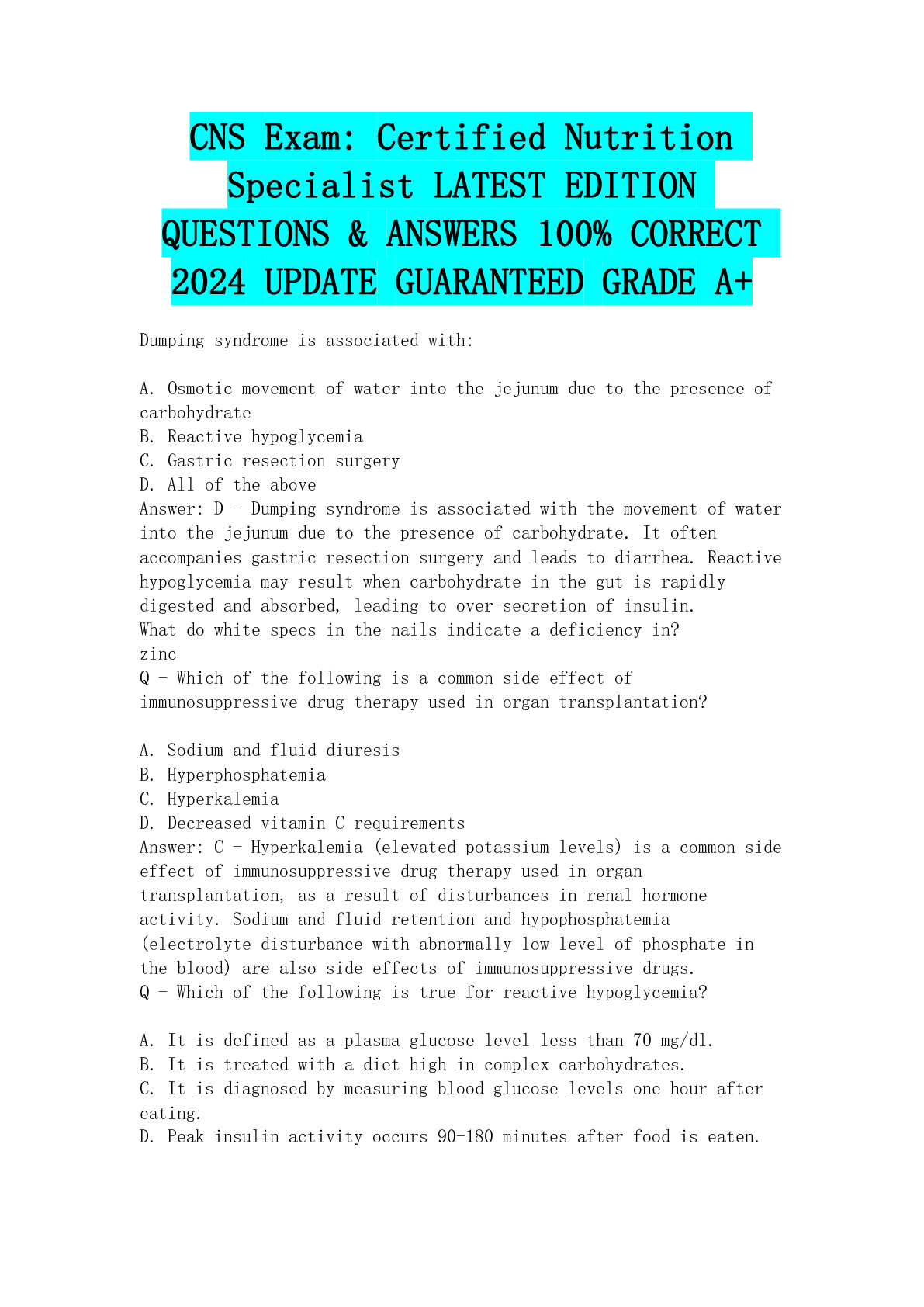
Reviews( 0 )
Document information
Connected school, study & course
About the document
Uploaded On
Jan 16, 2024
Number of pages
124
Written in
Additional information
This document has been written for:
Uploaded
Jan 16, 2024
Downloads
0
Views
13




